The Gender & Sexuality Issue
Jabez Choi explores the histories inside New Haven gay bars. 16

Theia Chatelle and Iz Klemmer follow three trans kids seeking gender-affirming care in New Haven. 34
Abbey Kim finds how queer Christians enrich their spiritual lives. 42
Volume 55, Issue 4 March 2023 The Magazine About Yale and New Haven
Letter from the editors
Dear readers,
The New Journal ’s tagline has always been: “The Magazine about Yale and New Haven.” Our mission, as we understand it, is to represent these spaces through the stories of the people who occupy them. Recently, we’ve been thinking more about how best to do so.
We began our year as a managing board by discovering a trove of dusty archives—hundreds and hundreds of time capsules of the University and the city. We ended the year with TNJFest, where the past collided with the present as alums of the last fifty years descended on the Branford Common Room. These bookends on our term have affirmed to us that TNJ is a living history, and journalism can do essential record-keeping. More than that, we’ve been reminded that longform can follow the narratives behind the numbers, make human the abstractions of headlines, and in doing so disrupt assumptions; contradict generalizations; and reveal gaps in the common discourse.
Across the nation, queer people are facing renewed threats. Dozens of bills have been passed in state legislatures this year that restrict transgender people from accessing gender-affirming care, despite medical consensus that this care is sound and necessary. Anti-LGBTQ + violence is on the rise, and the tired caricature of queer people as predatory “groomers” has reappeared in popular media. At what may be a regressive inflection point for LGBTQ + rights in America, the future hangs uncertain.
In this issue, Abbey Kim explores queer Christians’ ongoing battles for acceptance in their churches. Jabez Choi chronicles the decline of gay bars, and asks the question: what is the meaning of a “safe” space? Sasha Carney traces the history of lesbian social life on campus, and Jools Fu navigates the complicated masculinity of the Singapore Armed Forces. Theia Chatelle and Iz Klemmer explore the obstacles trans kids face when seeking genderaffirming care, while Hannah Szabó remembers the spaces and people that supported her own journey during childhood.
These stories aim to situate some of New Haven’s queer life in both history and experience. We hope to do in this issue the same thing we have sought to do since 1967, a purpose reiterated in our October 2001 issue’s letter from the editors: to put our moment in context.
Masthead
Editors-in-Chief Nicole Dirks
Dereen Shirnekhi
Executive Editor Jesse Goodman
Managing Editor J.D. Wright
Associate Editors
Amal Biskin Abbey Kim
Meg Buzbee Yosef Malka
Jabez Choi Cleo Maloney
Lazo Gitchos Paola Santos
Ella Goldblum Kylie Volavongsa
Yonatan Greenberg
Senior Editors
Beasie Goddu Madison Hahamy
Alexandra Galloway Zachary Groz
Copy Editors
Marie Bong Edie Lipsey
Adrian Elizalde Lukas Trelease
Rafaela Kottou Yingying Zhao
Creative Director Kevin Chen
Design Editors
Meg Buzbee Charlotte Rica
Camille Chang Karela Palazio
Etai Smotrich-Barr
Photography Lukas Flippo
Anson M. Beard
James Carney
Andrew Court
Romy Drucker
Jeffrey Foster
David Gerber
David Greenberg*
* Donated twice. Thank you!
Matthew Hamel
Makiko Harunari
James Lowe
Chaitanya Mehra
Ben Mueller
Sarah Nutman
Peter Phleger
Jeffrey Pollock
Adriane Quinlan
Elizabeth Sledge
Gabriel Snyder
Fred Strebeigh
Arya Sundaram
Stuart Weinzimer
Steven Weisman
Suzanne Wittebort
Members & Directors: Emily Bazelon • Peter Cooper • Jonathan Dach • Kathrin Lassila • Elizabeth Sledge • Fred Strebeigh
Advisors: Neela Banerjee • Richard Bradley •
Susan Braudy • Lincoln Caplan • Jay Carney • Andy Court • Joshua Civin • Richard Conniff •
Ruth Conniff • Elisha Cooper • Susan Dominus
• David Greenberg • Daniel Kurtz-Phelan • Laura
Pappano • Jennifer Pitts • Julia Preston • Lauren
Rawbin • David Slifka • John Swansburg • Anya
Kamenetz • Steven Weisman • Daniel Yergin
Friends: Nicole Allan • Margaret Bauer • Mark
Badger and Laura Heymann • Anson M. Beard •
Susan Braudy • Julia Calagiovanni • Elisha Cooper
• Haley Cohen • Peter Cooper • Andy Court • The Elizabethan Club • Leslie Dach • David Freeman and Judith Gingold • Paul Haigney and Tracey
Roberts • Bob Lamm • James Liberman • Alka
Mansukhani • Benjamin Mueller • Sophia Nguyen
• Valerie Nierenberg • Morris Panner • Jennifer
Pitts • R. Anthony Reese • Eric Rutkow • Lainie
Rutkow • Laura Saavedra and David Buckley
• Anne-Marie Slaughter • Elizabeth Sledge
Caroline Smith • Gabriel Snyder • Elizabeth Steig
• Aliyya Swaby • John Jeremiah Sullivan • Daphne and David Sydney • Kristian and Margarita
Whiteleather • Blake Townsend Wilson • Daniel Yergin • William Yuen
•
2 TheNewJournal
Thank you to our donors thenewjournalatyale.com
TNJ love, The Managing Board
Neela Banerjee*
A Scene of Outsiders
At Space Ballroom, Danya Blokh is in for a night of “non-denominational, non-binary” hardcore. snapshots
Yalesbians, Sappho, and the Lesbian
Life of the Party
A genealogy of lesbian social spaces at Yale.
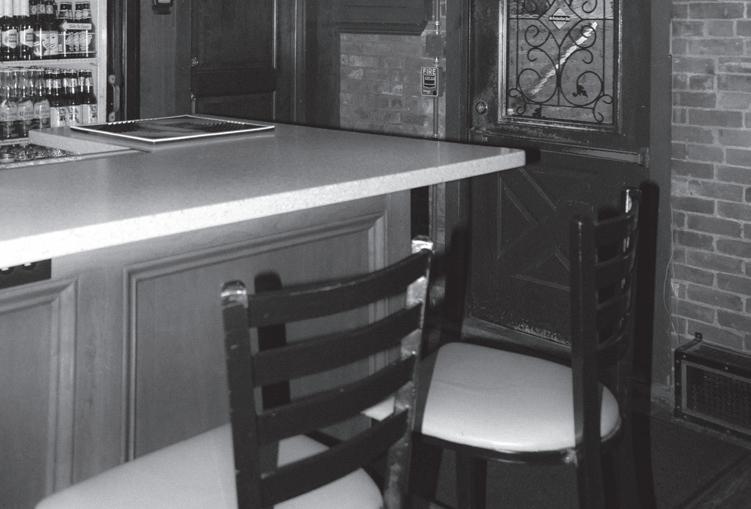 By Sasha Carney
By Sasha Carney
Drawing it Out
Local advocate Tony Ferraiolo guides trans youth—and their parents—through the complications of their gender journeys.
By Hannah Szabó
Counter Memories
cover story
Is gay nightlife getting quieter? A writer explores the histories inside New Haven gay bars.
By Jabez Choi
Waiting for Care
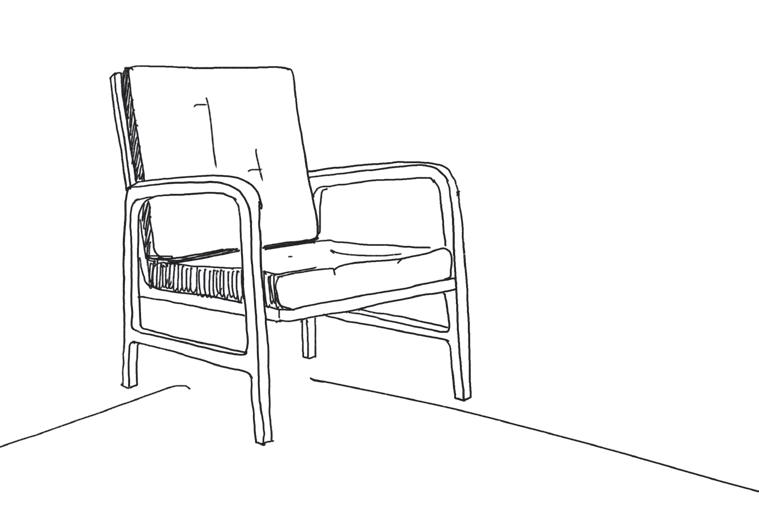
At the Yale Pediatric Gender Program, trans kids say they receive great care—but it’s not easy to get.
By Theia Chatelle and Iz Klemmer
Coming Out, Coming Home
Queer Christians in New Haven and at Yale are finding ways to enrich their spiritual lives through their lgbtq + identities.
 By Abbey Kim
By Abbey Kim
We Will Live in a Corner House
By Anaiis Rios-Kasoga
asides
Jennifer’s Body
By Anaiis Rios-Kasoga
Dash of Fancy
By Amal Biskin
poems for Abel
By J.D. Wright
Where Boys Become Men
Violence and masculinity in the Singapore Armed Forces.
By Jools Fu
Grocery Store
By Amal Biskin
Berlin Poem for Owen
By Ella Goldblum
Kissing One of Your Queer Awakenings
By Adrian Elizalde
crossword
**REDACTED**, crossword , by Jesse Goodman, page 55.
3
fiction
flash
March 2023 Contents 42 16 4 6 10 28 53 33 54 14 9 14 40
point of departure
personal essay
image credits: Nour tantush; kevin chen; aaron miller 34
A Scene of Outsiders
At Space Ballroom, Danya Blokh is in for a night of “non-denominational, non-binary” hardcore.
On February 12, 2023, Hamden’s Space Ballroom was a veritable convention of musical subgenres. Millennial hardcore fans in gray hoodies with the hoods up, older bearded metalheads wearing band T-shirts, and young queer punks with piercings and tattoos milled about the small, dim venue. The crowd’s energy felt more like a school dance than a punk show, and even though small mosh pits formed for hard-hitting local hardcore bands Intercourse and Kidnapped, they fizzled out quickly once it became clear that most fans preferred watching to dancing. As a casual fan of hardcore who had always enjoyed the collective catharsis of a good mosh-pit, I came toward the front of the audience and hoped for some mayhem as the headliner, Space Camp, ascended to the stage.
I got mayhem, alright. June Aino and Daisy Josefa, the two vocalists and core members of Space Camp, led a plethora of supporting musicians up to the platform, packing the small stage with an upright bass, a cello, a sousaphone, a trombone, a synth and a drum set, with a second drummer set up in the middle of the audience. The musicians smiled broadly as they sound checked, their classical instruments contrasting starkly with their tattooed arms and all-black outfits. But nothing could have prepared me for the overwhelming cacophony of orchestral punk that followed. Somehow, with no guitar or bass, Space Camp’s music was more forceful than any punk band I’d heard.
With the drummer in the middle of the crowd, there wasn’t any room to
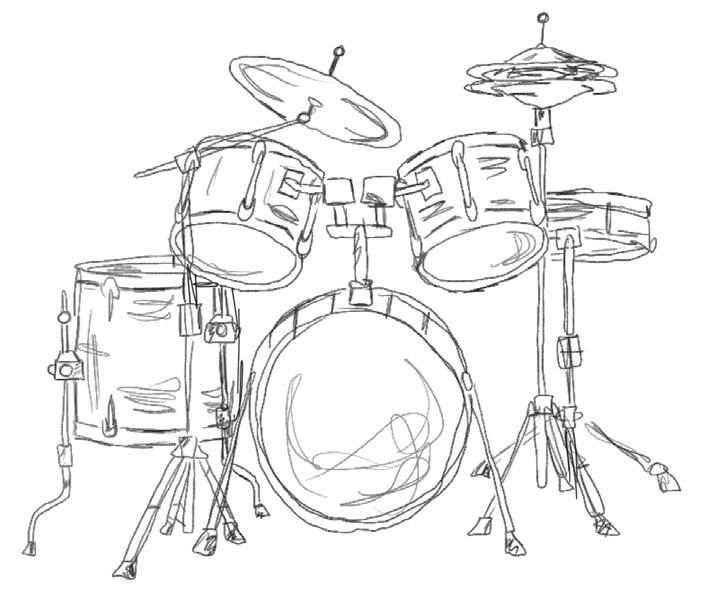
start a mosh pit. But there was no need for one; the crowd’s attention was fixated on the hardcore symphony before us. The chaos I’d expected in the audience was happening on stage instead: June and Daisy screamed powerfully, the brass instruments boomed, and the second drummer wielded a drill during one song and a bugle horn during another. One local reviewer noted in their article about the concert that the sheer force of Space Camp’s sound shattered a lightbulb in the bathroom, but no one around me blinked an eye. As one of the attendees, Connecticut resident Myles Vincent, phrased it afterwards, “it’s just an explosion. Rather than going to see a band go to play their songs, it’s like you’re going to see something go down.”
Brass instruments and power tools are rare at most live shows, but particularly in hardcore, an aggressive offshoot of punk music with a relatively strict sound and ethos. While the genre varies between bands and over time, there is nonetheless a defined set of expectations for hardcore songs: fast and brutal riffs, deeply screamed vocals, and climactic song sections called “breakdowns” intended to make listeners go wild in the mosh pit. Historically, hardcore’s aggressive attitude, as well as its lyrical preference for themes like hometown pride and the straight-edge lifestyle over the progressive politics of anarchist bands, attracted mostly male musicians and listeners to hardcore shows. Space Camp’s novel sound, which their bio calls “non-denominational, non-binary hardcore,” is unique in a genre as stylistically codified as hardcore. Consequently, whenever they’re booked on a show with a bunch of hardcore bands, “it’s a mixed bill, because we have single handedly mixed the bill,” says Daisy.
Yet this very love for instrumental play created Space Camp in the first place. June and Daisy became friends in fourth grade after finding themselves to be among the few fourth graders registered to learn trombone at their South Windsor Elementary School. “Our houses were so close together that we could walk through a neighborhood and some woods and be at each other’s houses,” says June when I speak with the band a few days after the show. Daisy started playing guitar and drums, while June kept learning trombone and picked up keys, and they briefly experimented with surf rock in high school before
officially forming Space Camp in March 2013. Their playful debut record consists of Daisy playing drums, June playing synth, and a friend reading passages aloud from books they found in their practice space. “At the time we were like, this is a cool concept,” says Daisy. “It’s since been wiped from the internet.”
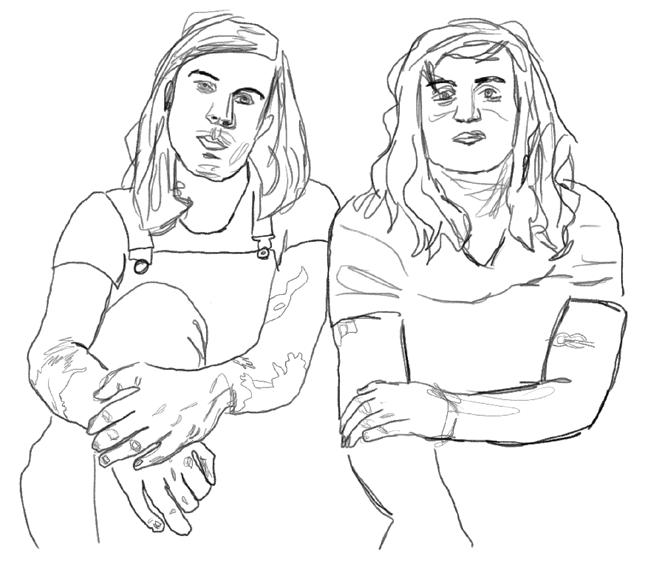
In 2014, the band added a bassist, June introduced a full piano in addition to their microKORG synth, and Space Camp began booking more shows and seriously recording music. Their stylistic influences at the time were hardcore bands like Ceremony, Punch, and Code Orange Kids, whose influence is still evident in Space Camp’s roughly screamed vocals, ominously dissonant chords, and punchy song sections. “We’ve always been suckers for a lip-curling hardcore breakdown,” Daisy tells me. Yet instrumental diversity remained integral to their ethos; listening through their Bandcamp releases, you’ll hear just about everything—tuba, guitar, contrabass, oboe—all absorbed into their heavy punk sound. Their latest album Gold Star was released in January of this year and continues this tradition with twenty-nine minutes of magnificent auditory havoc.
Space Camp’s take on hardcore has thrived in Connecticut largely because of the state’s unique music scene. Whereas more densely populated states tend to stratify into separate subgenres with minimal overlap, Connecticut’s small size leads to a melding of styles perfect for Space Camp’ eclectic blend of genres. As Daisy says, there’s a distinct charm to a place where only one show is happening on a given night: “If it’s a Friday night in Philadelphia in July, there’s six shows going on. You can get the best line-up at a sick venue, and everyone you know will still text you and say, sorry, we’re going to another show. But if we’re playing in Connecticut, everyone who’s interested is there, it is the thing to do.”
4 March 2023 TheNewJournal Points of Departure
illustrations by meg buzbee
Space Camp is only one example of Connecticut bands’ propensity for music experimentation. Tarek, the lead singer of Intercourse, says there’s an entire scene of local experimental punk—“I call it outsider hardcore ”—dedicated to fostering a left-leaning, welcoming milieu opposed to the exclusivity of more regimented music scenes. “We’re not into that macho, gatekeepy shit,” he says proudly. Intercourse, which has been playing since 2014 and is soon releasing their new album Halo Castration Institute, is itself a genre-bending project too, with “one foot in hardcore and one foot in noise rock.”

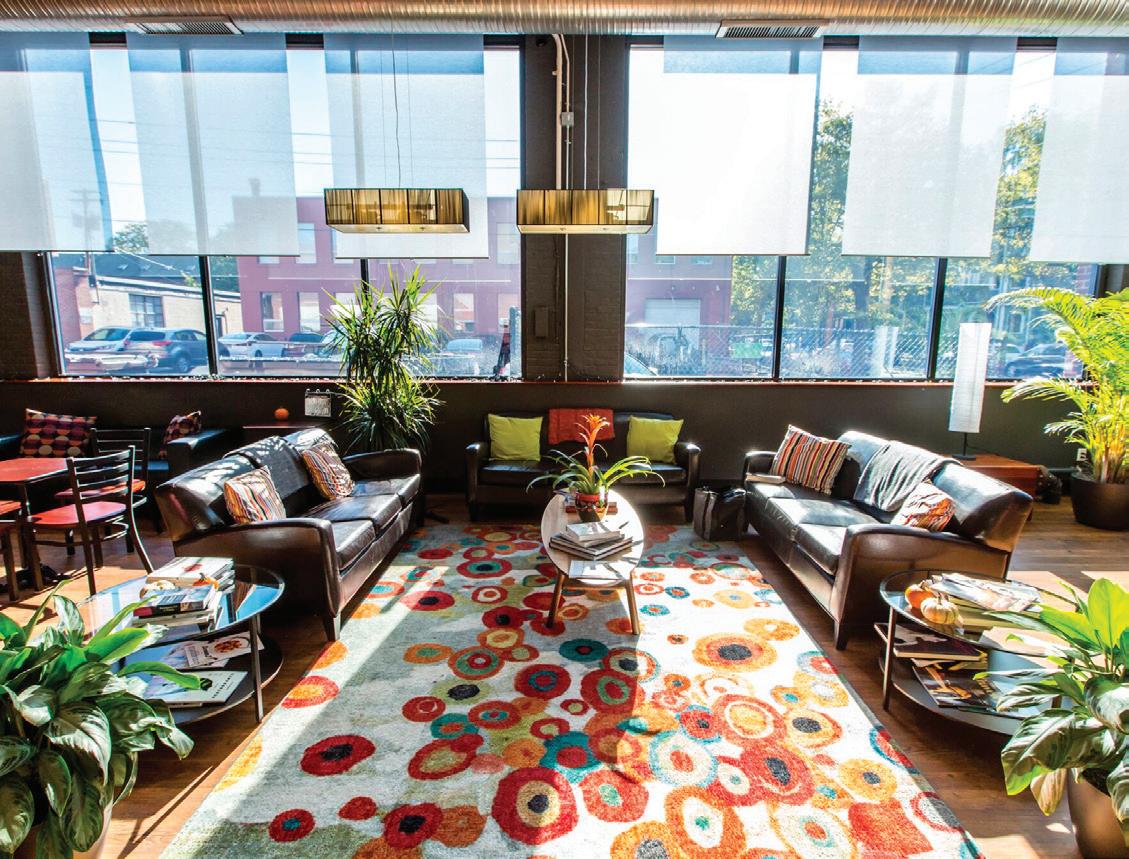
The Connecticut scene’s inclusivity doesn’t just apply to the music, but also to the community itself. While hardcore is often perceived as a hypermasculine boy’s club, Connecticut’s outsider hardcore shows are “a place for a lot of people where they can go and be themselves,” says Tarek. “If you want to wear make-up and goth out, no one’s gonna bat an eye.” Tarek, whose family is Egyptian, grew up as one of the only people of color in the small town of Naugatuck, Connecticut. His upbringing was full of alienating and aggressive encounters with white
schoolmates. Connecticut’s music scene was also exclusionary, though in different ways. “People at shows used to tell me, don’t wear a Marilyn Manson shirt or you’ll get the shit beat out of you, make sure to wear a Cannibal Corpse shirt or something neutral,” Tarek remembers, laughing. Yet the young, left-leaning audience of Connecticut’s current outsider hardcore scene makes no space for such hostility, from musical elitism to racism and misogyny. “There’s lots of trans people, there’s lots of queer people, there’s lots of people of color. This is a really inclusive scene for everybody, and we’re really proud of that. We’ve had people come through and say, wow, this little niche of Connecticut is really special.”
This warm and welcoming attitude suffused the venue after Space Camp’s set concluded. Young newcomers to the scene and longtime outsider hardcore fans alike chatted eagerly with me about what we’d just experienced together and about other shows they’d recently attended. If the disparate contingents had struggled to gel at the start of the night, the singular intensity of Space Camp’s eclectic sound seemed to have bonded everyone at the Space Ballroom, dissolving any residual awkwardness in the space.
I shook hands with Daisy and Tarek, who both warmly thanked me
for coming and told me they’d be glad to interview. In the merch line, one fan told me he’d grown up in Connecticut, moved to Austin for nearly a decade, and only just returned. The scene in his time had been aggressive and intimidating, he told me, and the warmth of Space Ballroom’s crowd shocked him. Though this was his first time seeing Space Camp, his beaming smile while talking about his experience at the concert suggested he was bound to become an outsider hardcore regular.
I left with a newly purchased Space Camp T-shirt tucked under my arm. Every time I’ve worn it since, at least one person has stopped me to ask if I caught them at Space Ballroom. Daisy was right about the perks of a small music scene; these people really had all been to the same show as me. The next time I find myself toppled over in a Connecticut hardcore mosh pit, I’m certain one of these familiar faces will be around to lift me up. ∎
Points of Departure
Danya Blokh is a junior in Timothy Dwight College.
285 Nicoll Street, New Haven CT 06511 203-936-9446 www.mactivity.com Fitness Center
Title illustration: Space Camp’s June Aino, left, and Daisy Josefa, right.
Where Boys Become Men
Violence and masculinity in the Singapore Armed Forces.
 By Jools Fu
By Jools Fu
Content warning: This piece contains a description of self-harm.
My combat boots were still flecked with dirt and my forest-green fatigues were covered in mud and sweat. Somehow, my beret sustained its creases despite soaking up the bits of camouflage face paint that I hadn’t managed to properly wash off. The city was dead quiet. It was 3 a.m., my phone was out of battery, and I had to walk home from the hospital.
My nineteen-year-old recruit, Bing Jie, was hooked up to an IV and probably fast asleep. Two months ago at this time, he probably would’ve been at home, awake maybe, playing video games, watching TV. At the time when he first enlisted, he told me, he was a professional League of Legends player. He had come fourth in a national competition the year before. In terms of national service, he really wanted to serve in the cyber security division. Instead, he was tossed into infantry, and he came under my charge. Rhabdomyolysis had
broken down his major muscles. Now, he couldn’t walk without excruciating pain in both legs. The moment when he had collapsed into a messy heap of limbs and grass, he couldn’t even call out for help.
While we were in the waiting room, Bing Jie’s dad and older brother arrived. After a terse conversation with me, they sat with him on the other side of the room, away from me. They tried their best not to talk to me directly, and neither of them used my name. I was “sergeant,” a tool of the state’s military apparatus.
6 March 2023 TheNewJournal
Personal Essay
photos by jools fu
Basic Military Training (BMT) is a milestone in the lives of all Singaporean men. It marks their mandatory enlistment into the Singapore Armed Forces (SAF). The training center isn’t even on the mainland; boys are packed onto ferries and shipped to Pulau Tekong, an island right off the coast of Singapore. It’s where their identification cards are exchanged, and suddenly they are no longer “citizens” but “NSF” (Fulltime National Servicemen). It’s where the SAF shaves the boys’ heads and the tropical sun burns their scalps. It’s where they fire their first rifle, where they dig their first trench, and where they start the endless cycle of physical and strategic combat training. After two months of grueling regimentation, recruits graduate and are then assigned to military vocations. The top 20 percent of recruits are sent to command school to undergo further combat training, Officer Cadet School (OCS) to become an officer, or Specialist Cadet School (SCS) to become a sergeant. But BMT is the start of any military career. Its motto: “Where boys become men.”
I entered BMT as an 18-year-old, having gone to high school in the United Kingdom and therefore largely unfamiliar with Singaporean society. National Service had always been something I dreaded. All throughout high school I had been bullied by other boys, who called me a “faggot” and kicked me when teachers weren’t looking. I was often reduced to tears, made to feel unfathomably small, and helplessly alone. If high school was like that, I couldn’t imagine what the army would be like. I considered myself a progressive, I thought militaries shouldn’t exist, and I knew my queerness was not accepted. I made the conscious choice to remain closeted. I enlisted with the bold assumption that the army was not going to change me or my beliefs. But to avoid being criticized or belittled, I tried my best to excel in this performance of masculinity.
I did well. My athleticism translated well to military training. I accepted the torrent of insults and verbal abuses my sergeants hurled at me. And when I was commended for my abilities, a part of me truly enjoyed it. For the first time in my life, I was considered tough and strong. I completed BMT fifth in my platoon of sixty-four, and I earned a position in SCS. A week later, I started my training to become a sergeant and a commander.
In SCS, I spent six months learning
more advanced forms of combat and familiarizing myself with a diverse array of weapons, from machine guns to RPGs. I navigated miles of dense vegetation while carrying a seventy-pound field pack. I survived in the jungle for nine days without any contact with the outside world. With the completion of each exercise, the joy I found in the military became more real. I enjoyed infantry training in a way that would have been entirely alien less than a year before, intoxicated with my adaptation to an ideal masculinity. When I graduated, I was assigned to be a BMT trainer. Upon receiving my posting order, I promised myself I would be different, patient. “Be the change you want to see” was what I kept repeating to myself.
I remember the first time I made another person cry. He was part of the
alienated. I was barely sleeping, and I hardly had time to eat. So, when I caught a glimpse of a recruit running out of his bunk to grab an extra bun from the parade square after lights out, I lost it. What came out was closer to barking than yelling, and it echoed so loudly that some heads peeked out from the fifth floor. “What the fuck do you think you’re doing?” He dropped the bun instantly, keeping his head down as I unleashed my wild wrath on him. As he walked away, I realized the blotches on his shirt were not sweat marks, but tears. When I reentered the company office, my friends and fellow commanders dapped me up. Later, my captain pulled me aside and commended me for enforcing discipline. As I went back to my bunk, I smiled for the first time in a while.
first batch of recruits I ever trained. In the first few weeks of their training, the recruits are given snacks to eat at night, as a part of their grace period: packaged buns, stuffed with artificially flavored cream the color and texture of playdough. The buns tasted like nothing but sugar, which was pure heaven compared to the nauseating food that we ate at the cookhouse. I’d had a rough day—contrary to my expectations, being a trainer was not simple and I was growing more and more frustrated with how ineffective I felt. My strategy of patience seemed completely inept compared to the fear other commanders were able to strike into their recruits. As much as I wanted to be morally strong, I felt myself becoming
Bing Jie was in my third and final batch of recruits. By then, I had grown into a seasoned trainer. I had learned to harness my unbridled fury on my recruits, breaking them down physically and mentally into passive bodies, moldable soldiers. My rage was a defense mechanism, a way to throw others off my trail. If I could be “tough” and harsh on my recruits, no one, not even the boys from high school, could call me a “faggot” anymore. Before enlistment, a batch is given a grade based on their expected physical and mental competency. My first two batches had been A’s; Bing Jie’s was a C, and I felt the difference immediately. No matter how hard I pushed, they couldn’t meet my timings. They were consistently late, none of them could perform any marching drills in sync, some couldn’t even hold up a rifle without shaking from the effort. It was a combination of physical inability and mental disinterest. But I had to be the one that got them there.
The Combat Circuit is BMT ’s most difficult physical training. It requires recruits to dress in full battalion order, including field packs, suffocating armored vests, and heavy helmets. Then, they’re thrown into an outdoor training ground, made to climb steep hills, dash from tree to tree, and crawl through thick mud. The exercise is supposed to simulate the motions of jungle warfare. When I was a recruit, our sergeant shouted insults at us as we did the circuit, and I did the same to my recruits. Nothing was off limits. I was telling them how worthless they were as they scrambled about, their rifles swinging
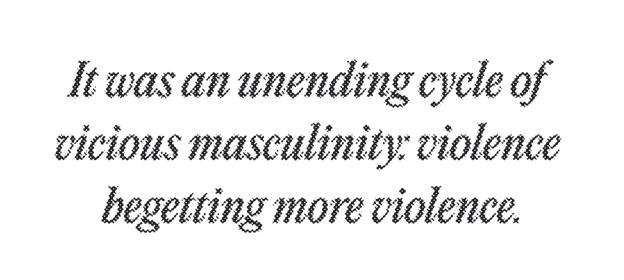
7 TheNewJournal March 2023
layout design by Kevin Chen
wildly by their neck, knocking into their chins. Suddenly someone shouted out in alarm. Bing Jie had disintegrated into a crumpled heap underneath his field pack, which was larger than him. I thought he was faking it. Three hours later, after the medical staff had evaluated he needed to be sent to a hospital, I volunteered to go.
My commanding officer gave me the next few days off, and my house wasn’t far from the hospital. Under moonlight, the quiet roads felt like burgeoning gulfs. I reached into my pocket to find a crushed pack of Marlboro Reds for a smoke, a habit I had picked up in SCS, but I couldn’t find my lighter. Somewhere along the way, a car drove past me, its headlights illuminating my dirty silhouette against an empty shopping mall. At the sight

of me, the driver was startled. I felt like a ghost from the jungle, a savage specter haunting the city. About a mile from my house, I passed by the twenty-four-hour McDonalds that I used to beg my mum to take me to when I was a kid. A group of drunk teenage boys was there, trying to scale the attached playground. I was reminded of combat obstacle courses. In a couple years at most, they too would be starting BMT, like I had, like Bing Jie did, like all of us would. It was an unending cycle of vicious masculinity: violence begetting more violence. Staring at them, I felt a shuddering discomfort. I averted my eyes and walked home.
In the next two months, I graduated from the military and arrived at Yale. On my first night out in New Haven, my combat boots soaked up sticky concoctions of beer, vodka, and fruit
mixers instead of the squelching dirt, dead leaves, and rifle shells of the jungle floor. As I danced in the middle of the sloshing crowd, a group of men snaked their way in, bluntly pushing through me. A couple months prior, I would’ve shoved back, maybe more. But, something had shifted since that night walk. To protect myself, I had adopted the violent tools of those before me, leaving Bing Jie in the hospital. Performing masculinity had not caused more harm. So I simply stared at them, not wanting to engage anymore.
I thought that I’d find solace in queer spaces, because it was the first time I could be so open about my own queerness. At an Office of LGBTQ Resources mixer, I was handed a nametag. “What do I write here?” I asked someone. “Your pronouns!” they answered. I tentatively put down “he/him,” unsure if it was
8 March 2023 TheNewJournal
Where Boys Become Men
who I wanted to be anymore, but equally terrified of the alternative. The group shared their collective trauma: the ways in which they were shunned, bullied, and derided for their difference, largely by the men in their lives. I thought about every punishment I had ever subjected my recruits to. With each anecdote getting heavier and heavier, I left early, ashamed of myself. I hadn’t said a word to anyone.
I felt helplessly alone those first few months, but I refused to ask for help. On Halloween night, while everyone around me prepared their costumes and left for parties, I laid paralyzed in my dorm. Without thinking, I grabbed a pair of scissors from my table and made around a half-dozen slashes on my forearm. Later that night, one of my suitemates called 911, and I was escorted to the psychiatric ward of Yale New Haven Hospital. While undergoing innumerable administrative, psychological, and medical procedures, what struck me the most was how easily my body fell into the monolithic category of “male.” I kept thinking about my position in the genealogy of manhood that I had known before: from the boys in school, the sergeants that trained me, and finally me to Bing Jie. I didn’t want to be a part of the lineage anymore. When I left the hospital, I walked back to my dormitory in the clear, cold New Haven morning air. The sun was the brightest thing I could see and a part of me strangely felt stable. Being a “man” was eating me alive, so I decided to stop.
In five months, I will have spent more time outside the military than in it. There is always an impulse to romanticize those times: the late night instant noodle parties, the raves we went to on our days off, the satisfying sense of exhaustion after finishing an exercise. I still miss catching crabs off the old bridge that we snuck out to when our recruits were asleep, and the genuine moments of tenderness in between smoke breaks and barking orders. That’s what I instinctively remember about all of it. But the SAF’s commands are all still there, in encrypted WhatsApp messages on my phone. When writing this piece, I spent hours sifting through them. The image of Bing Jie, unable to even crawl in that field, is still there. ∎
Jennifer’s Body
The first time I watch Jennifer’s Body I am a budding adolescent huddled under my comforter during the first few months of the pandemic. Stale bedroom air presses into my lungs while crumbs brush against my unshaven legs. Over the next hour and forty minutes I am overcome by an unfamiliar zeal as I take in the bright outfits, hilarious dialogue, and mid-2000s emo soundtrack that plays while Jennifer Check and her best friend Needy unconvincingly pretend they aren’t in love with each other. The twentieth time I watch the movie is on 35mm at The Roxy in New York during my first summer on my own. I linger at the entrance and smile when I realize I can’t spot a single man. In fact, I am surrounded by women who definitely had a crush on Megan Fox when they were 14. And in the velvet enclosure of the theater, we are teenagers again. The salt and butter of fresh popcorn mingles in the still air. We are suspended in a collective coming of age. We are filled to the brim with the kind of zeal you experience when you are finally seen.
9 TheNewJournal
Jools Fu is a sophomore in Pierson College.
Aside
Anaiis Rios-Kasoga
Snapshot
Yalesbians, Sappho, and the Lesbian Life of the Party
A genealogy of lesbian social spaces at Yale.
By Sasha Carney
Anna tender was “already very out” as bisexual when she came to Yale in 2018. Her first week on campus, she followed the stream of nervous first years to the fraternity houses on High Street, towards what seemed to be the archetypal college party: red Solo cups, a watered-down keg, and unremarkable music shaking the sticky walls. As she relaxed into the party, she began to dance with a girl next to her, letting her hands rest easily on her waist. Half-drunk, and thinking of very little except enjoying the night, Anna kissed her.
“Huge mistake,” she says of the public kiss now. A man leaned in and asked, leering, “Can I join?” They broke apart. Over the next few days, she found that the news of the kiss had spread through her residential college, without her knowledge or consent. People she barely knew “freaked out” at the fact that Anna, with her long hair and more femme style of dress, hadn’t been what they expected of her. A carefree moment turned into a public dissection of her sexuality. “After that,” she says about the party, “I was like, ‘Oh, okay. I get it. This is not a space for me.’”
She stopped going to frat parties, and started befriending more queer women: people she met in classes, her modern dance group, mutual friends, and hookups. Somebody added her to an email list for an organization called “Sappho,” an informal social group that hosted a semesterly party for queer women and nonbinary people. They promised a night out free from the
anxiety that Anna felt at frats. Her sophomore year, she arrived at a “Euphoria”themed party in the basement of the women’s rugby team apartment on Elm Street. This was no Bud Light-ruled rager: attendees adorned themselves with glitter, sipping colorful, intricate cocktails made by student bartender Lauren Lee. She had already started to
in 1987, at least “one in four” students are some kind of gay, lesbian social life is hardly an underground niche. But over the decades, Yale’s lesbians and queer women have wrestled with how to carve out a social life that is safe but still exciting.
1970s: Yalesbians begins
In September 1975, a record twelve women attended a meeting of the Gay Alliance at Yale (GAY), a mostly male discussion and advocacy group. It was the height of the lesbian feminist movement, and some young lesbians were growing frustrated with what they saw as the patriarchal focus of gay activism across the United States. Four years before, the Yale Women’s Center was founded as a space for undergraduate women to gather. In 1970, the activist Del Martin published an essay, “If That’s All There Is” in the lesbian review The Ladder, where she condemned gay rights organizations as sexist. Lesbians—growing doubly frustrated by the homophobia they experienced from straight women and the marginalization within gay spaces—felt they needed a space to breathe.
attend “smaller, more intimate” parties dominated by queer women, from wine nights hosted by girlfriends of friends to a set of lingerie parties hosted by an all-woman society. But Sappho was the largest gathering of queer women she’d seen in one space.
At “the Gay Ivy,” where, according to a Wall Street Journal article published
Two lesbian undergraduates, the out-and-proud Tara Ayres and a partially anonymous woman identified only as “Sarah” by The Yale Daily News, formed a Yale-registered sister group to GAY known as “Yalesbians.” On a balmy September night, twenty lesbians and self-identified “straight woman” allies met for the first time at the GAY room
10 March 2023 TheNewJournal
Lesbians—growing doubly frustrated by the homophobia they experienced from straight women and the marginalization within gay spaces— felt they needed a space to breathe.
in Hendrie Hall. They adopted the format of “consciousness-raising circles,” open feminist discussions where women connected wider political issues to the struggles of their everyday lives. The organization also co-ran multiple projects with GAY, including a telephone counseling service and a weekly radio hour called “Come Out Tonight.”
Yale’s Weekly Bulletin and Calendar initially ignored requests to publicize Yalesbians’ weekly meetings. After a few weeks, they finally responded and began to reluctantly spread the word. Through word of mouth and print ads, membership grew to about one hundred people. As co-founder, Tara noted Yalesbians’ membership was a low estimate of the true proportion of lesbians on campus, arguing in a 1977 report to the Yale Corporation that the average gay woman at Yale “is probably not vocally a lesbian, and is afraid to be identified as such.”
On New Year’s Eve in 1976, a fire destroyed part of Hendrie Hall, burning out the room where Yalesbians and GAY met, as well as the headquarters of the service frat Alpha Psi Omega. While the frat was re-housed almost immediately, the administration dodged Ayres’ inquiries about finding a space for Yalesbians for over a month. In late February, Tara and GAY member Jack Winkler were finally able to march up to the Associate Dean of Student Affairs’ office to secure a new space in Bingham.
Off campus, meanwhile, many lesbians could still find social and political community in the lesbian feminist scene in New Haven. “By the end of the [1970s],” Yale alum and former Yale LGBTQ history professor George Chauncey wrote in The Yale Alumni Magazine, “New Haven was home to an extraordinarily vibrant and complex women’s culture and lesbian feminist movement: the Feminist Union; feminist bookstores, women’s health centers, self-defense classes.” While Yale lesbians (and Yalesbians) found political homes in New Haven’s more radical feminist scene, they often came cleaved closer to campus to party.
1980s: Lesbians after hours
By the late nineteen-seventies and early nineteen-eighties, separatism was no longer the word of the day. Maia Ettinger, a former official leader of Yalesbians, told me that by the nineteen-eighties, the gay “scene” was more
multiracial and cross-gender than the “pretty white” nineteen-seventies separatist world. She moved off-campus to 12 Whalley Avenue, where she lived with fellow Yale gays Judith Rodenbeck, Lisa Kennedy, and the late Donald Suggs, who later became known as a Black gay activist and journalist during his postgraduate life in New York City. While Maia was a leader of on-campus lesbian life at weekly Yalesbian meetings, the household threw after-hours parties that brought campus gays together on more relaxed terms.
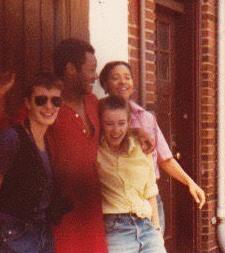
Rather than being exclusively lesbian, the household “invited everyone cool, which was cool with us,” explains Maia. Though the parties skewed gay, they allowed proud lesbians and straight lefties alike to dance to Boy George, Annie Lennox, and Prince, who were bringing queer aesthetics and sensibilities into popular music for what felt like the first time.
Listening to Maia sketch out her gay world, I was enthralled by the vibrancy of her social and political life. I also started to wonder how my life would have unfolded on the gay campus of 1982. I certainly wouldn’t have identified as nonbinary the way I do today—Maia confirms that while “androgyny” was the word of the day, and something many campus lesbians pursued, the language just “wasn’t available” to identify outside of womanhood.
Romantic and sexual relationships flourished—most queer women that Maia knew had both casual encounters and long-term girlfriends. On nights out at several gay off-campus apartments, open lesbians made out with the girls who had attended weekday Yalesbians meetings as “straight allies.” The mood was both celebratory and anxious, and increased visibility came at a cost. In 1982, Yale’s LGBT Co-operative held the first Gay and Lesbian Awareness Days (GLAD), which culminated in an on-campus dance for which the administration gave permission. Maia remembers a group of football players had overheard that a girl they knew, someone they certainly didn’t think was gay, was attending.
One athlete stood outside the door, trying to intimidate her, and Maia “just hauled off and punched him in the eye.” She was proud to see him later that week with a black eye. The gays danced on. Hostility continued to accumulate. In February 1984, the senior class threw a party at what is now Grace Hopper College, where the 17-year-old daughter of a Yale faculty member was kicked in the stomach by male students. The men taunted the girl, and the female friends she was dancing with, with chants of “Lesbos!” Susan Arkun, a Yale College student who was verbally harassed at the event, explained to the News that in social spaces she was often met with derision owing to her short dyed hair. “I wish those lesbians would leave so we could tap the keg,” she overheard once. Strangers shouted “Yalesbians!” at her on the street.
Maia freely accepts that in the face of these explosions of homophobia, some of her football player-punching bravado was bluster. She wishes the gay communities on campus had the language
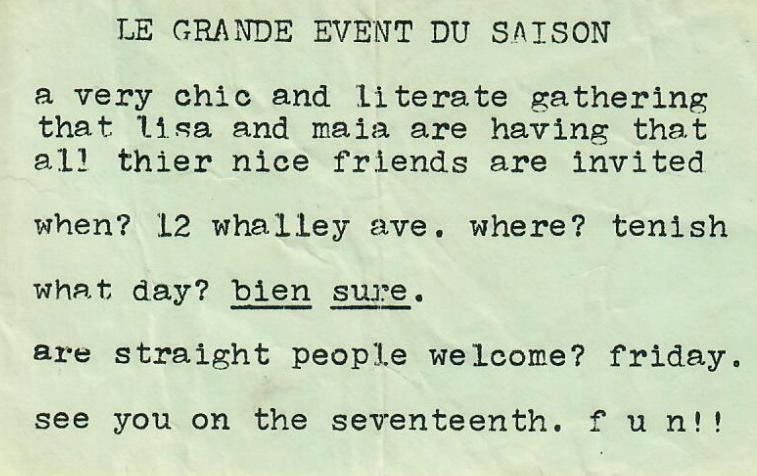
11 TheNewJournal March 2023
layout design by kevin chen
Above: Maia Ettinger and her off-campus “household.” Below: a Yalesbians party invitation.
Photos courtesy of Maia Ettinger
at the time to articulate “how frightened we actually were.” At 18 or 19, she explains, “maybe you access anger more easily than you access your own vulnerability.” Parties are a good way to deflect from the fact that it is often difficult to be young and gay and alive.
Sappho comes out
Yalesbians faded, let down by a quick student body turnover and a lack of institutional memory. The group’s archives were smaller and more informal than a lot of other, larger, official student orgs. Leadership changed hands, over and over again. By the time the third millennium rolled around, Yalesbians’ weekly, Wednesday meetings had stopped. I combed through campus newspaper archives to find some concrete reason for the organization’s dissolution, but came up with nothing. The last mention of the group I could find came in 1995, when the News advertised a regular Yalesbians meeting as part of “Sexuality Awareness Week.”
But lesbians, specifically, still wanted a space to come together. Sappho, named after the Greek poetess who gave us the word “lesbian,” was founded by an unknown group of queer women in 2004. Unlike Yalesbians, who were a registered student organization receiving Yale funding, Sappho began—and remained—an informal social collective. Sticking true to Yalesbians’ 1979 declaration to “never again turn to the YDN” to publicize their work, Sappho in 2010 started to reach other on-campus queers in the most 2010 of ways: a blog.
On sapphoyale.blogspot.com, “queer, questioning, lesbian, bi, trans, and everything else in between women at Yale’’ could post, anonymously or not, about anything that came to mind. In the style of full-on early 2010s hyper-enthusiasm, they gushed about their sexual awakenings (“I LOVE TOPPING Eeeeee.”), brought gay political news to the blogosphere (“Yay, queer people can now visit thier [sic] partners in hospitals just like married people!”), and rejoiced over queer pop culture (“how awesome was glee in so many ways? way awesome.”) The blog encompassed the complexities of lesbian social life in the emerging digital age. On the one hand, queer women on campus could now stay connected to each other at all times, even in physical isolation. Dozens of posts popped
up over summer and winter breaks, lamenting homophobic households and celebrating hometown pride parades. But in some ways, with the arrival of the internet, lesbian spaces were also in the process of becoming more isolated, more dispersed. Websites like Tumblr, which flourished in the early 2010s, allowed younger queer people to “come out” under digital aliases, while remaining closeted in their day-to-day life, not taking the risk (and thrill) of venturing into physical queer spaces. Lesbians could raise their consciousness from the
comfort of their home, without looking another queer in the eye.
The blog only lasted a year before being replaced in September 2012 by a series of zines called “Hey Girl!” Perhaps Sappho’s new leadership, tiring of the dispersed nature of the digital, wanted to throw it back to the heyday of analog feminism. The DIY-style zines, frequently thrown together over the span of one night, were a deliberate aesthetic homage to the anarchist, punk, and Riot Grrrl subcultures of the nineteen-eighties and nineteen-nineties. They set out

12 March 2023 TheNewJournal
Yalesbians, Sappho, and the Lesbian Life of the Party
sapphoyale.blogspot.com provided a way for queer women on campus to stay connected amid the emerging digital age.
an ambitious agenda for what Sappho would bring to the “queer ladies’’ of Yale, including guerilla art, skillshares, protests, “parties and pregaymes,” and—supposedly—naked parties in the Yale Women’s Center. The zine was earnest, funny, and pro-Beyonce. One full-page spread of collages and hand-scrawled slogans encouraged readers to “queer up Yale ‘’ in any way they knew how. “GET OUT



THERE! YOU DO YOU!” the caption blared over a drawing of a Venus symbol, a printed-out picture of the Hulk, and an invitation for lesbians everywhere to
“make friends’’ and “make enemies.”
The zine folded after four issues. The idea of “parties and pregaymes” stuck around. Though it’s incredibly difficult to track down the “official” emergence of Sappho parties, in 2014, a Silliman student named Zoe heard, through Facebook groups and word of mouth, about a semesterly party for sapphic people only. The series of Sappho parties, which was funded entirely by the friend groups of juniors who put them on, was “passed down” each year to a new friend group of queer women deemed sufficiently cool,
with enough off-campus space to host. “Everyone seemed to know about it, but I can’t tell you how,” she recalls.
This sense of uncertainty and anonymity, which persisted throughout Sappho’s existence, is a kind of double-edged sword: these social spaces are at once unconstrained by official channels and institutional funding, and difficult to historicize or pin down. Of course, “everyone” can also never entirely encompass “everyone.” Though Sappho invitations were entirely open, most knowledge of the parties, like in Maia’s day, boiled down to who already knew who.
As sophomores, Zoe and her roommates were selected to throw next year’s Sappho parties, but with few guidelines and no funding by the women who came before them. With money they had saved from campus jobs and donations from attendees, they put on a couple successful events where “people were definitely there to hook up.” Zoe recalled these parties as “more mixed-race and more genderfruity” than most other campus parties, and found herself encountering butchness as a possibility she could pursue for the first time. Attendees felt at ease picking up women in ways they didn’t elsewhere on campus—ways Anna didn’t at the frat party her first year. The next year, Zoe and her friends passed the baton to another Silliman friend group. She confesses that she has no idea if they carried it on.
They did, although some people grew frustrated with the slowness of the parties’ semesterly format. “I think we need more parties to cruise at and have sex at,” recent Yale alumnus Mia Arias Tsang told me bluntly. She spent most of her time on campus surrounded by other queer women of color through her work at Broad Recognition, a campus feminist publication. Though she was already in those environments in her day-to-day life, she was looking for more explicitly sexual and romantic lesbian spaces afterhours. She remembers her disappointment at missing a Sappho party in 2017 where attendees reportedly did body shots. Anna both expressed to me that although she wasn’t seeking sex at the parties, being in multiple monogamous relationships through her time at Yale, she enjoyed their distinct atmosphere, at once both electric and celebratory.
When Mia did attend the fall 2019 Sappho party in the rugby basement, she felt a huge “pressure to fuck” owing to how infrequent and unpredictable the
13 TheNewJournal March 2023
Yalesbians, Sappho, and the Lesbian Life of the Party
Pages from the Sappho zine “Hey Girl!”
Sasha Carney / The New Journal
Asides
Dash of Fancy
At seventeen, I devoted myself to the pursuit of eroticism. Evolutionary imperatives necessitated a baseline sexual appetite, but I was more concerned with Sontag. “In place of a hermeneutics we need an erotics of art,” Sontag contends in her 1966 essay “Against Interpretation.” In a miasma of theory, she believed that art had lost its fervor. Now, with heads cocked to analysis, audiences set out on interpretive undertakings at the first twitch of a curtain rising, at the edge of a frame, in the didactic aisles of a title page. We no longer laid ourselves bare and let art wash over us. We no longer felt the acerbic burn when its saline waves seeped into wounds we had forgotten.
I was no different. An erudite floozy, I had taken to reading the wall text before looking at the painting. No longer! With “Against Interpretation” in tow, I set out to let art stir me. Orgasm was the endgame. But like an addict whose senses were dulled by their fix, I could no longer get off on art alone. I craved a hit of theory, chased the electric jolt of recognizing classical allusion. I was Paolo and Francesca in Dante’s fifth Canto, tossed about by blustering waves of desire. Fuck, that was good.
Music was my first exception. If I sat very still in the dark and turned my headphones as loud as they would go, I could start to detect the buds of excitement. Alone in my room, I had no one to tell that Berlioz was quoting the dies irae in the fifth movement of “Symphonie Fantastique.” Instead, I let the crashing gongs throb unanalyzed. I trembled with emotion. I was redeemed.
Amal Biskin
Grocery Store
I learned desire in the aisles of the grocery store. It was a world of pleasure, of throbbing stimulation and tantalizing unknowns. So many things were off-limits: cheese puffs beckoning me with their curved fingers; cookies in perfect rows, glistening through plastic windows; bottles of soda, jewel-like in their translucent vibrancy (surely the liquid itself was not that bright green, I reasoned, and what did a mountain taste like?); rows and rows of cereal boxes like a city on the cutting edge of nightlife, fractal-like in their varieties—this one chocolate and that fruity, this with raisins and that oat clusters, this frosted and that with marshmallows and another frosted and with marshmallows! The hope that these delicacies could one day be mine helped me cope with the profound emptiness I felt knowing that there existed flavors and textures beyond my wildest dreams. With the barebone constituents of my existing culinary experience, I cobbled together succulent fantasies to tide me over until I could satiate myself for real. I imagined frosting so creamy it felt like the softest part of a child’s palm, chocolate so expertly balanced between sweet and bitter it could remain upright on a tightrope, gelatinous candies that my teeth would sink into like they were slipping into sleep.
Amal Biskin
14
parties were. She felt that these opportunities were somewhat scarce, and felt anxious about not taking full advantage of them. “I went with friends who all peeled off and found other people to have sex with,” she recalls. She adds that she was pleasantly surprised by the amount of lesbians of color there, but “at any Yale space,” she acknowledges, “as a queer [woman of color], if you’re trying to get laid, it’s going to be hard.” Still, she came away grateful for the experience, and excited for next semester. But before the next party, Covid hit.
Today: Everyone is gay
As of 2023, “lesbian life” or “queer women’s life” spills out into much of everyday life at Yale. With outness not only encouraged at Yale, but essentially the default in vast swathes of the campus’ academic and social world, many lesbians don’t have to look for “lesbian groups” or “gay issues” to find the comfort and community they seek. “It felt like my life was inherently a queer space in a way I never experienced before college,” Mia explains. Many other queer students echoed this sentiment, feeling that while they variously enjoyed Sappho parties, they didn’t feel the need to attend them to find sex, love, or friendship.
“I don’t think I hang out with anyone who isn’t queer,” Ava Dadvand, an Iranian trans lesbian, decided after thinking for a moment. She finds most of her queer friends through Beyond the Binary, an official on-campus trans and nonbinary social group, as well as through social media, friends of her partner, and other mutual friends. A lot of it is incidental. On an increasingly “out” campus, you can meet other lesbians and sapphic people with ease from a class seminar to the line for lunch. Add in the queer-centric social spaces of Yale Twitter, as well as the opportunities for casual sex and romance from dating apps, and you’re giving Sappho-specific bulletins like Sappho.blog and Hey Girl! a run for their money.
The definition of a “lesbian social space” is also increasingly changing as the idea of “lesbianism” does. While the Sappho of the early 2010s nominally included trans women in the labeling of their organization (if not in the content of their blogs and zines), the language of the world of “lesbians” has become more complex and gender-diverse as medical and social transition become increasingly
possible. Last semester, I had top surgery through Yale Health. Newly healed this semester, I feel more comfortable at parties and excited to dance, but more anxious in things closer to “women’s spaces.” I jump back at the thought of throwing someone off in a bathroom or changing room. I believe “lesbian spaces’’ can, and should, include people like me, but I don’t always feel at ease in those dominated by cisgender, gender-conforming women. The concept of a “lesbian-only” or “woman-only” space can sometimes be code for “cis women-only,” something Maia worried
is bioessentialist. “It’s drilled into our heads, for better or for worse, that lesbianism is associated with pussy.”
While campus “lesbian life” has become more trans, Sappho parties have arguably become less so. After the onset of Covid-19, what events have popped up feel distinctly lackluster. Lily, a senior who started attending Sappho events in 2022, describes the two parties they stopped by simply as “boring.” The music was soft, the drinks were sparse, and the energy was conversational—more of an “affinity group” than a party space. After recently beginning to present more masculine, they were acutely aware that the people they met at a fall 2022 Sappho party were “almost all femmes, and pretty white too.” They headed home early.
Attendance at these last two parties was small, something exemplified by the relative lack of undergraduate knowledge about Sappho. When I asked her about Sappho parties, Ava, who arrived at Yale in 2021, confessed “I don’t know what that is.” The same things that make Sappho exciting, flexible, and cool—the lack of Yale institutional ties or funding, the informality of leadership, word of mouth—also make the whole operation hard to maintain. By the time someone intending to throw a Sappho party has the means to bring their idea to fruition, they may have already graduated. Not to mention, there’s no unified vision behind what makes a Sappho party “good.”
about when I described Sappho parties to her over the phone. “The parties aren’t trans-exclusionary, right?” she asked sharply. I assured her that they weren’t, at least not in their advertising. But it’s certainly possible that some trans people stay away.
Ava is perfectly happy finding a home in what she calls “dyke spaces,” but also notes that she’s found it a lot easier since she had bottom surgery last summer. She concedes that this sounds “bioessentialist” of her, overly focused on genitalia as the site of sexuality. But, after all, she explains, our society
I, for one, don’t want the Sappho party tradition to die out. Lesbian nightlife on campus—the kinds experienced by Ettinger in the nineteen-eighties, or what Anna reveled in as a first-year—is facing a number of challenges. The difficulties of resurrecting marginalized party spaces after Covid, the hesitancy around where exactly to define “lesbianism” or “queer womanhood,” and the uncertainty around whether exclusively gay social life even needs its own space on such a strongly queer campus, all seem to lead people to pause before they send out an invitation to a naked party in the Women’s Center. I say, there’s value in taking the extra, deliberate effort: to carve out a semesterly space, to reach queer women beyond your social group, to confront the contradictions of a lesbian night out. Let the gays dance on. ∎
15 TheNewJournal March 2023
Sasha Carney is a senior in Silliman College.
The definition of a “lesbian social space” is also increasingly changing as the idea of “lesbianism” does.
Yalesbians, Sappho, and the Lesbian Life of the Party
Counter Memories
Is gay nightlife getting quieter?
A writer explores the histories inside New Haven gay bars.
By Jabez Choi
16
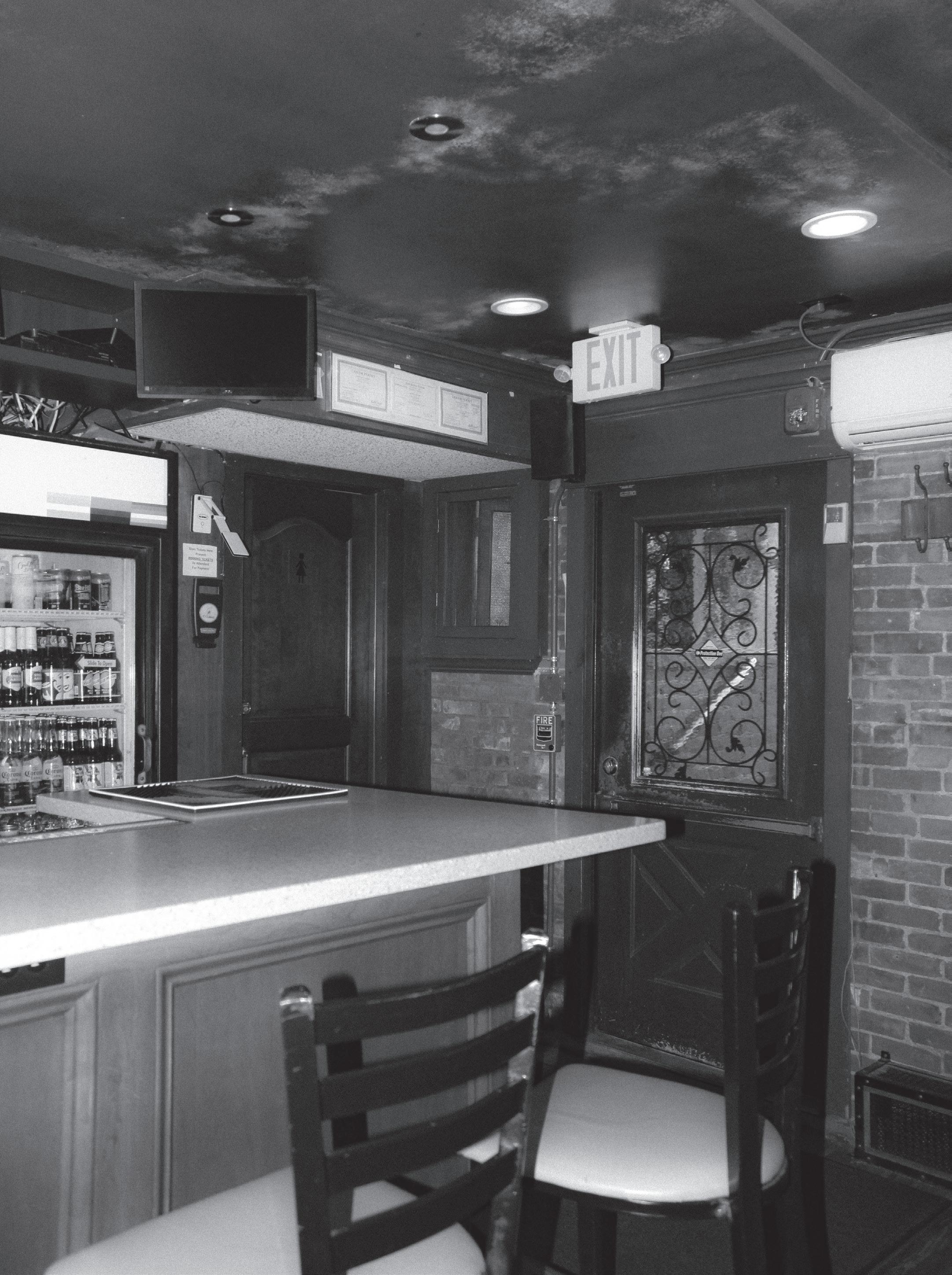
17
Layout design by Kevin Chen & photographs by nour tantush
It is a building that looks like it is hiding. Some windows are blurred with frosted glass. Others are boarded up. The walls are painted an aged white, peeling at some parts. On the side of the building, a small, orange sign names the building: Partners. Underneath a piercing streetlight, just next to the mural of a smiling Anne Frank, a man stands by himself, a lit cigarette in his mouth. Nothing on the outside reveals that the building is one of the oldest gay bars in New Haven.
On Fridays and Saturdays, Partners opens its second floor to reveal a glittery night club. There, mirrors cover the walls and a spinning light shines on young, dancing bodies in the dark. Those are the endless nights—loud and hazy and crowded. On Sundays, the second floor closes, leaving the ground floor open for karaoke night. It draws in a smaller crowd. Now, it’s Monday night in February and the bar is barren—except for Paul, me, and two drunk men. The two men had waited outside the bar’s front door before he’d arrived. Now, they sit at the counter with me, babbling over each other. They interrupt Paul while he talks to me, asking for another drink. Paul leaves to fill up their shot glasses.
“I was telling him how annoying it is when people showed up to the bar at seven fifty-nine, knocking on the door,” Paul says, nodding towards me.
They cackle in response.
“If your ass is open at eight, you better be open,” one of them shoots back.
Paul half-smiles. Then, he turns to me and rolls his eyes.
I like Paul for two reasons. The first is that he speaks to me like a friend. By nature, I am an anxious person. Despite this, we quickly chat like two old gossips. The second is that he is seasoned. He moved to New Haven from Massachusetts over a decade ago to work at Partners. This is his eleventh year behind the counter, and it shows—he is fluid, quick with his words. He’s seen more than me.
“So what was the gay bar scene like when you first started working here?” I ask.
“I want to say it was more gay men. Today, we have everything. Like, sometimes I’m working and I’m like, when did this become a straight bar?” he says, pouring another drink for one of the men. “There’s a lot of different types of people that come in and out of here all the time.”
As he talks, these broad terms—“everything,” “different types of people”—become clearer. Paul tells me that Partners defines itself as a gay bar, a gathering ground that has historically served queer people in New Haven. However, the events that the bar hosts—karaoke open-mics, bingo nights, goth dances, drag shows—now draw in straight people alongside the typically queer crowd. It isn’t abnormal to run into straight couples on a Friday night. Partners’ clientele widened over the years; the bar became a space for a broader, open-minded community, rather than a specific queer one. Though these capacities still have queer communities in mind, the formerly rigid boundaries have blurred.
“So the culture of the clientele has changed?” I ask.
“Yeah, absolutely. I mean, it doesn’t ruin the vibes or anything. It’s just that times are changing. Gay bars, straight bars, you’re going anywhere you want,” Paul says. “No one’s really afraid to come here anymore. I mean, ten years ago, the straight men, they’d be like, ‘Oh, my God, I’m not going to a gay bar.’”
I understand. The culture change Paul talks about is something that has manifested in my generation, my lifetime. I was twelve when the Supreme Court recognized gay marriage as a legal right. I watched characters on television proclaim their gayness to accepting arms. I had openly queer friends who I fought and reconciled and grew up with. Whenever I hated myself, I could look at my queer friends and recognize that they were lovable. And through my love for them, I knew I was lovable too. In an odd way, I recognize that my ability to do this is evidence of an undeniable societal shift. Could this shift change landscapes of queer gathering? What happens to a space when the stigmatization that used to define it is dissolving? I think these questions as Paul talks.
“Then, does this mean gay bars are not needed anymore?” I ask. “As opposed to, say, any old bar?”
“Well, we still need them. I mean, Partners? It’s always going to be Partners. Everyone’s going to be coming here,” he says, assuredly. “It’s just now, it’s like a space for almost everybody.”
“So what does Partners mean to you?” I ask.
“A paycheck,” Paul jokes. The two drunk men next to me laugh.
I meet Bernard at Partners, two hours before opening. I have never seen the bar so empty and quiet. The main room is dark except for two spotlights that shine overhead. We sit in adjacent seats by the counter. I begin to fidget. When I look at Bernard’s hands, I notice that he, too, is fidgeting.
Bernard mentions growing up in a conservative family in a small town in Mexico. In 1993, Bernard immigrated to the United States. He was in his twenties and exploring New Haven gay bars. At Partners, he met Dave Klemens. Today, the two are married and run the bar together as co-owners. According to Bernard, not much has changed over the years in how they run their business. They have their cheap drinks, their drag shows, their busy weekends and softer weekends.
“The community has been evolving but we don’t exactly change with them, you know,” he says. “You can do everything on phones. But I mean, person-to-person is better. I don’t know how to explain it.” He pauses. Then—“That was the model the previous owners founded. And Dave kept doing the same thing. If it’s not broken, why fix it?”
Gay bars depend on the “person-to-person” model that Bernard emphasizes in a way that differs from any other bar. Usually, people go to bars to meet other people over a drink, to form a community, to relax and let loose. But the notion of a gay man letting loose is a radical act in this context. It means sexual identities could finally be actualized. It means camaraderie in a society that has condemned
18
Counter Memories
Could this shift change landscapes of queer gathering? What happens to a space when the stigmatization that used to define it is dissolving?
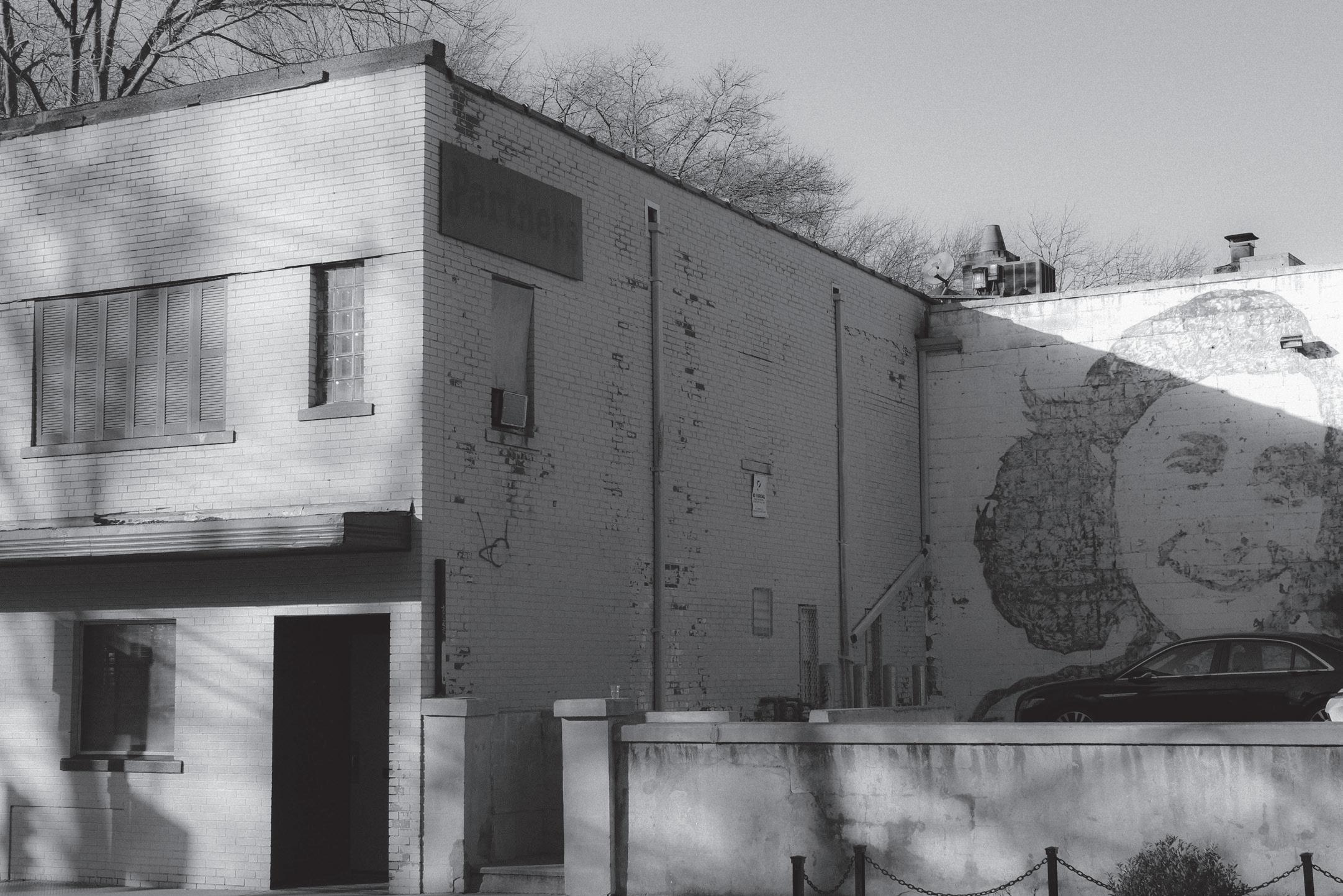
19 March 2023
Counter Memories
The unassuming exterior of Partners and its accompanying mural of Anne Frank.
queer lives. These often anonymous communities were essential to an entire generation of gay men; these bars were one of the few places they could gather. Outside the normative hours, into the nighttime, one could experience their first sexual encounters with other queer people in the liminality of the gay bar. With little barriers to self-expression, the gay bar becomes a place of genesis. Unique queer aesthetics were born: leather and kink sub-cultures, drag personas, cruising codes, creations a heteronormative society might find abnormal. Bernard puts it in a simpler way.
“For me, it was just liberating to come to a gay bar. I knew I was gay, always. But it wasn’t talked about until I came here.” he says. “You see your gay friends. It’s gay community so it’s fun, you know?”
Bernard tells me that Partners was founded in 1974 by Jack Garity and two friends, who ran the bar for fifteen years before handing it off to Dave. Almost fifty years later, the bar is still open. It had survived the peak of the epidemic and the twenty-first century decline of gay bars nationwide. In March 2020, the bar closed due to the coronavirus pandemic. The face-to-face intimacy that the bar provided for the queer community momentarily disappeared. Nevertheless, once Bernard and Dave got state approval, they opened their doors again in May 2021. People flooded the bar and lined up out the door, clamoring to get inside and dance. In a time in which businesses were closing left and right, the community showed out for Partners.
Perhaps Partners is one of the lucky ones. The years between 2007 and 2019 saw a closure of 37 percent of gay bars across the United States and the pandemic ensured the closure of even more. More dire, around 200 lesbian bars have closed since the 1980s, leaving twenty-seven lesbian bars in the nation today according to the Lesbian Bar Project. There have been numerous theories to explain this sudden uptick in closures. Some blame dating apps like Grindr or Scruff that have replaced the gay bar’s person-to-person model. Some blame an exhaustion among gay consumers, resulting from the extensive marketing of spaces and products as “gay” or “queer.” But others seem to hint toward a changing of attitudes within the LGBTQ+ community. Namely, that with a new generation marked by queer acceptance, the need for specific gay spaces as safe spaces is diminishing. In the context of the gay bar, acceptance almost seems like a contradictory phenomenon.
“There will always be the same need for gay people: love and acceptance,” Bernard tells me. “And we’ll provide that here. Because you can make a fool of yourself here. You can go to another place that accepts gay people but you need a safe space. You know that you are different and you always need a place to see your friends.”
He holds his hands up: “This is it.”
In my head, I repeat love and acceptance. I decide to take him for his word.
In between interviews, I stop by the New Haven Pride Center. Inside, I meet Juancarlos Soto, the interim director of the center. When I enter, he has just gotten off the phone. After we talk, we find out both of our fathers are pastors. I laugh at this coincidence. We sit in a room covered with rainbow flags. On the wall beside us, there is a mural of men dancing. Queer history books line the bookshelf next to him. The room is warmly lit by a lamp, illuminating his face. We’re sitting in a chapel of queer paraphernalia.
“I think sometimes we can create harm when we call something a safe space, because the reality is violence still happens, even within our own community. I still interact with queer spaces that don’t feel safe,” Juancarlos says. “Unfortunately, the same things we were fighting fifty years ago are still the same things we’re fighting today. In terms of how anti-trans folks are describing trans individuals and non-binary folks, it’s really the same playbook that we were using in the eighties. It’s just we swapped around terms.”
When Juancarlos describes “safe” queer spaces, such as the Pride Center or New Haven’s gay bars, he likes to call them “brave” spaces. It is an acknowledgement—though aspects of safety have arrived with acceptance, in Juancarlos’ eyes, acceptance has not fully arrived. And if safety cannot truly be guaranteed, why offer a false promise? Any queer space demands the bravery of queer people to exist.
It feels strange to assume acceptance has arrived. Less than halfway through 2023, the United States has seen more anti-LGBTQ bills than the past five years combined. These bills have included a wide range of attacks, from bans on gender-affirming care and drag shows to the discontinuation of LGBTQ education in schools. Last year saw the murders of at least thirty-eight transgender people in the United States according to the Human Rights Campaign. And memories of Colorado Springs, where a 2022 shooting at a gay club left five dead and seventeen wounded, are still fresh on the minds of many gay club-goers. Yet, though queer violence continues to persist, Juancarlos and I both agree that the queer community has changed dramatically.
“The ways the HIV epidemic and guilt have marked older generations compared to how its marked younger generations are very different, right? Because of how much more we know around prevention and how fewer deaths we have now in comparison, when you talk to younger generations, the way you talk about the virus is almost flippant in younger generations compared to older adults,” Juancarlos says. “I think all of those things create differences in their experiences and the issues that they face. But I think if we pause and talk to each other, we may realize that they’re more like the same things that we were fighting.”
He’s right. Scrolling through TikTok, I come across influencers like Zach Willmore, who has been vlogging his life since his positive HIV test results. The videos are mundane. In some, he powders his face with makeup while talking about his medication treatment. In others, he shops for shoes.
20 TheNewJournal Counter Memories
It feels strange to assume acceptance has arrived. Less than halfway through 2023 ,
The end result, even on an interface like TikTok, is revolutionary—HIV is no longer seen as a death sentence. But with this cultural shift, a strange dilemma arises: is normalization synonymous with forgetting? Juancarlos celebrates these generational changes. At the same time, he still seems concerned, unconvinced. We are still fighting the same things.
“The movement sort of went dormant and silent. We were like, ‘Oh, we have gay marriage. We have a president on TV talking about his evolution on same sex marriage. We don’t have to worry about high risk infections of HIV.’ Mind you. Black and brown, specifically, black trans women, were getting murdered at incredible rates,” he says. “Honestly, the LGBTQ community sort of got complacent. It feels like we are going backwards these days.”
Astreet over from Partners, another gay bar called 168 York Street Cafe hides in the basement of a brick townhouse. Its windows are shy, peeking just barely above ground level. From the outside, I don’t notice too much. Maybe the movement of a dim shadow. And a faint Whitney Houston melody. When the night falls, loneliness calls . . .
When I enter, I hear the disco of the seventies, the divas of the eighties—Whitney Houston, Cyndi Lauper, Donna Summer. It’s a far cry from the glitzy dance-pop that had reverberated from Partners’ speakers. Nobody here dances. There is no need to. 168 York is a pub, not a nightclub. Instead of movement, there is the warm clamor of voices. The handful of patrons all seem familiar with one another, sitting on the long counter, talking over each other, laughing. Once in a while, a man walks in and the noise crescendos. People look up, nod, hug, say hello, then goodbye. Amidst the noise, Joey Goodwin, the owner of the bar, sits at the very end of the counter, a seat usually reserved for him. I sit next to him.
“Look at this handsome gentleman interviewing me,” Joey tells a leaving friend. “Oh, who am I kidding. You look old enough to be my grandson.”
I laugh. It’s true. I am the youngest in the room by many years. As I sit next to Joey, I realize I have never in my life been surrounded by older gay men. Age, I realize, is a strange privilege. For an older generation of gay men, lives seemed quickly lived. In a way, escaping youth was an odd accomplishment. Here, all these men sit laughing, in a future they have created for themselves. The wooden walls—a worn brown—testify to the bar’s age. The floor’s faded planks creak at certain steps. Joey used to sand the floors when he needed to deep clean. Now, after so many years, he can’t sand them down anymore without their nails breaking loose. Between the previous owners and Joey, 168 York has existed in some form for about sixty years, making it Partners’ senior. The bar, like Partners, has stood through the heights of the AIDS epidemic and COVID -19, as well as a fire that burned down its old location in 1978.
Joey talks about the levels of caution that used to exist for gay bars. He tells me bar-goers would park
streets away from the bar and wear reflective jackets to obscure their identities as they entered and left. Anonymity was synonymous with nightlife.
“You had nicknames when you were going out, you know. People said ‘Call me Charlie, call me this, call me that,’ So everyone had names until you’re going back to the pub again and all of a sudden Charlie didn’t show up,” he says. “Then you found out that Charlie wasn’t his real name. And then you found out that if you didn’t see him in six months, you were sure he passed away.”
He quickly says goodbye to a departing friend. Turning back, he takes a sip of his drink.
“People who were different came to a gay bar because there was no place else to go. Gay bars were shelters for them,” Joey says. “You wouldn’t see too many straight people in the gay bar back then. They were homophobic. We lived undergroundpurposely.”
Joey sees more straight people entering 168 York now. This isn’t anything that bothers him. In fact, he finds it humorous. He describes how a straight man will walk in, bypass the rainbow flags hanging above the drinks, the trans pride colors on the refrigerator, the drag show advertisements on the walls, and sit down for a drink. As more of the regulars walk in, the man will slowly realize where he is. Joey describes the man’s sudden nervousness when he asks the bartender if 168 York is a gay bar.
“I love it. It just entertains me the most. I’m saying to myself ‘God, I hope so-and-so doesn’t come in. They’re going to give the whole thing away!’” Joey says, laughing.
“Do you think the gay bar should in some way be gate-kept?” I ask. “As in just for gay people?”
Joey shakes his head. “No. I always wanted to be an educator. Being a bar owner, you have a responsibility to say this is unacceptable, this is acceptable.” he says. “I thought the only way that I would ever fulfill that dream was to have people come in here and let them know that we’re not as bad as they think.”
How Joey sees it, gay bars are used as a kind of guided discovery. By having straight people confront queerness in the gay bar, the fear regarding sexuality becomes obscured and ideally, leads to an obvious reckoning—that queer people, at their foundation, are human too. In the gay bar, the straight man becomes othered by his straightness. Sexuality is not defined by its relation to heterosexuality. It is defined, for once, in the context of queerness.
“Are people trying to start new gay bars these days?” I ask.
“I don’t see anyone waiting in line to open up a gay bar, that I can tell you,” he says. “They don’t want any more duplications of a gay bar anymore, because everything’s so diluted now. Most people don’t have to go to a gay bar anymore.”
“Do you think at one point . . .” I start to say.
He interrupts me, already knowing my question. “Your question is, okay. There was a need for a gay bar but because of cultural changes, you’re thinking how long I can stay in the game for.”
I nod. He looks back at me knowingly. In the background, there is an eruption of laughter. Someone,
21 March 2023
Counter Memories
the United States has seen more antiLGBTQ bills than the past five years combined.
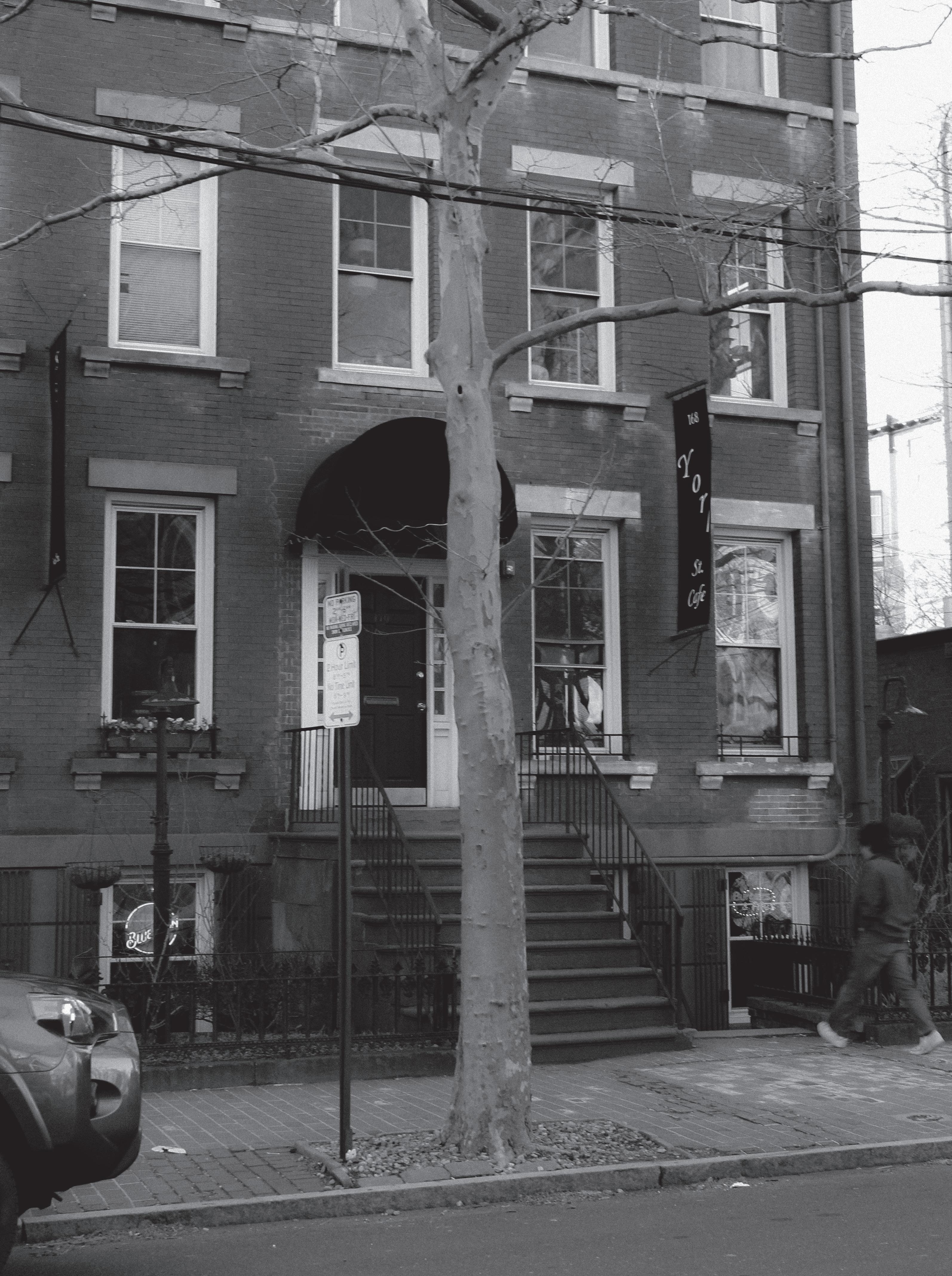
22 TheNewJournal Counter Memories
In the gay bar, the straight man becomes othered by his straightness.
Sexuality is not defined by its relation to heterosexuality. It is defined, for once, in the context of queerness.
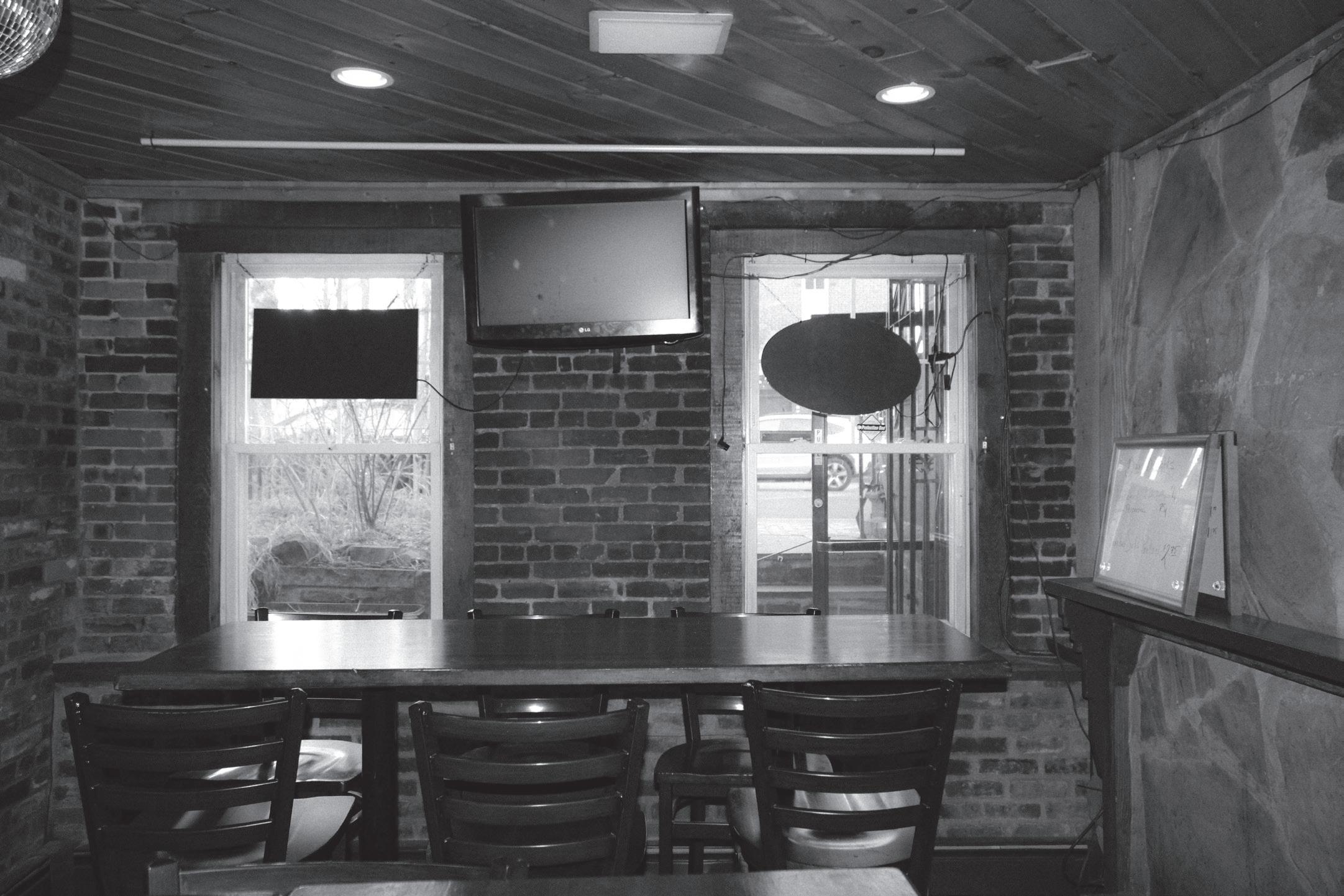
23 March 2023
Counter Memories
Outside (left) and inside (above) 168 York Street.
another friend of the bar, must have walked in.
“I question myself every day about that,” Joey says. “More and more people keep accepting the fact that there are different people. And because of that, our customer base is dropping. Now people are accepted. They can go anywhere they want right now, and have a really good time.”
As he says this, I look at his face. His voice does not change, nor does he look upset.
“Why do you think the bar has lasted as long as it has?” I ask. “Through so much?”
“We are resilient,” he says. His voice quiets. “But why? That’s the question.”
I pause when he says this. Joey had asked a question that I often think of: Why do we have to be resilient? Put another way, why does it cost so much strength to live?
The next day, 168 York is empty. The noise that filled the bar the night before has slipped out the window. Behind the counter, a bartender shuffles a set of cards, then lines them facedown on the counter. He plays by himself. I do not bother him.
In the next room, I meet Seth Evans. He is just about to have his weekly dinner here at 168 York. He sits under a dim spotlight, sipping on a golden drink. It glows in the light. Seth was the last editorin-chief of a Hartford-based LGBTQ+ publication called Metroline. The magazine intimately captured queer New England life from the AIDS epidemic to just after Connecticut’s legalization of gay marriage in 2008. Between their coverage of the epidemic and interviews with activists, the magazine advertised the Connecticut bar scene. Seth knows many of the bars closely, especially 168 York, where he would write many of his own articles for Metroline at the counter.
“What does the gay bar mean to you?” I ask.
“The bar scene means to me what it means to the first person that walked into the oldest gay bar in Connecticut,” Seth says. “Sanctuary.”
“Sanctuary,” I repeat back to him.
“The normal kid grows up in a home environment where they’re seeing Mom and Dad, and all the normal heterosexual way things are supposed to be. Where does that kid get guidance?” Seth said. “If you don’t come out to the clubs and allow yourself to be yourself, you’ll never know who you are.”
This form of sanctuary is well-encapsulated in the pages of Metroline. Near the beginning of most issues, there are pictures of New Haven gay bars at their prime. A camera’s flash reveals wide smiles, sparkling drinks, bare skin. The dark rooms are filled to the brim with bodies. Queer joy is abundant. Underneath, captions read their locations: Chapel Pub Cafe, Choices, Maxie’s, Saloon —all older New Haven bars. Large bar advertisements adorn almost every other page. The back of each Metroline edition reveals a list of clubs for each Connecticut city, all of which have advertised in the issue numerous times. The sentiment was clear—the clubs were open and alive.
“We started doing the magazine spreads of all the photos,” Seth says. “People would be very, very interested. They would go ‘Oh, I might be in it’ and they all started grabbing the magazine to look at it.”
As the years passed, though, Metroline began to falter. As more advertisers began using online mailing lists and other digital methods, Metroline, alongside other advertisement-reliant publications, took a hit. By the early 2010s, the magazine had become defunct.
“The internet started coming in. And that started killing the magazine,” Seth says. “The bar owners more and more started saying, ‘Why should I pay an ad in your magazine?’ It just became financially not feasible to keep the magazine in print because the bars weren’t paying.”
Over the years, the bars listed on Metroline ’s backpages started cycling out, too. Seth says himself that the lifespan of a bar at the time was at most seven years. In New Haven, the gay bars—Choices, Maxie’s, Saloon—slowly became replaced with the Brownstone, the Krpyt, Beach Head Cafe. And after a few years, those new names disappeared from the pages of Metroline. The addresses still exist today, but in their places, new businesses now stand. In some cases, only empty, desolate buildings remain. At a certain point, the only gay pubs that stood were Partners and 168 York.
“Will the bars continue to be a sanctuary?” I ask.
“It’s not as potent now as it was then. You’ll see straight couples come in and sit down and have drinks for a while. The acceptance, I don’t know if it’s a good way or a bad way, kind of diluted the population.” he said. “You found different people coming in, you know, it became like foreigners in our sanctuary.”
“Acceptance,” to Seth, marked a departure from a point that a previous generation lived through. But how do we make progress while remembering the past?
“Do you feel that your experiences pre-acceptance are valued by my generation?” I ask bluntly.
“They don’t know that they appreciate it yet,” he says. “Each of these generations contributed, you know, little bits of acceptance, little bits of acceptance, little bits of acceptance, it was a great wall built by one stone at a time.”
In a Metroline article titled “Remembering Stonewall,” a contributor writes, “Our present community needs to remember the event with clarity The 25th anniversary of the Stonewall Riots is a suitable reminder to do the right thing.” Later in the article, the writer honors the Black, transgender and gender non-conforming activists who had been leading the queer liberation movements since the nineteen-sixties. In a later issue, the fear of a collective queer amnesia is spelled out in an op-ed titled: “WE MUST NEVER ACCEPT AIDS.” The contributing writer opines to the remaining gay community that an acceptance of AIDS would be “forgetting” an entire generation of “brothers” lost to the disease. One advertisement pages after reads in large, bold lettering—“You can get HOSPITALIZED. You can DIE.” The last word takes up most of the page.
24 TheNewJournal
Counter Memories
At a certain point, the only gay pubs that
stood were Partners and 168 York.
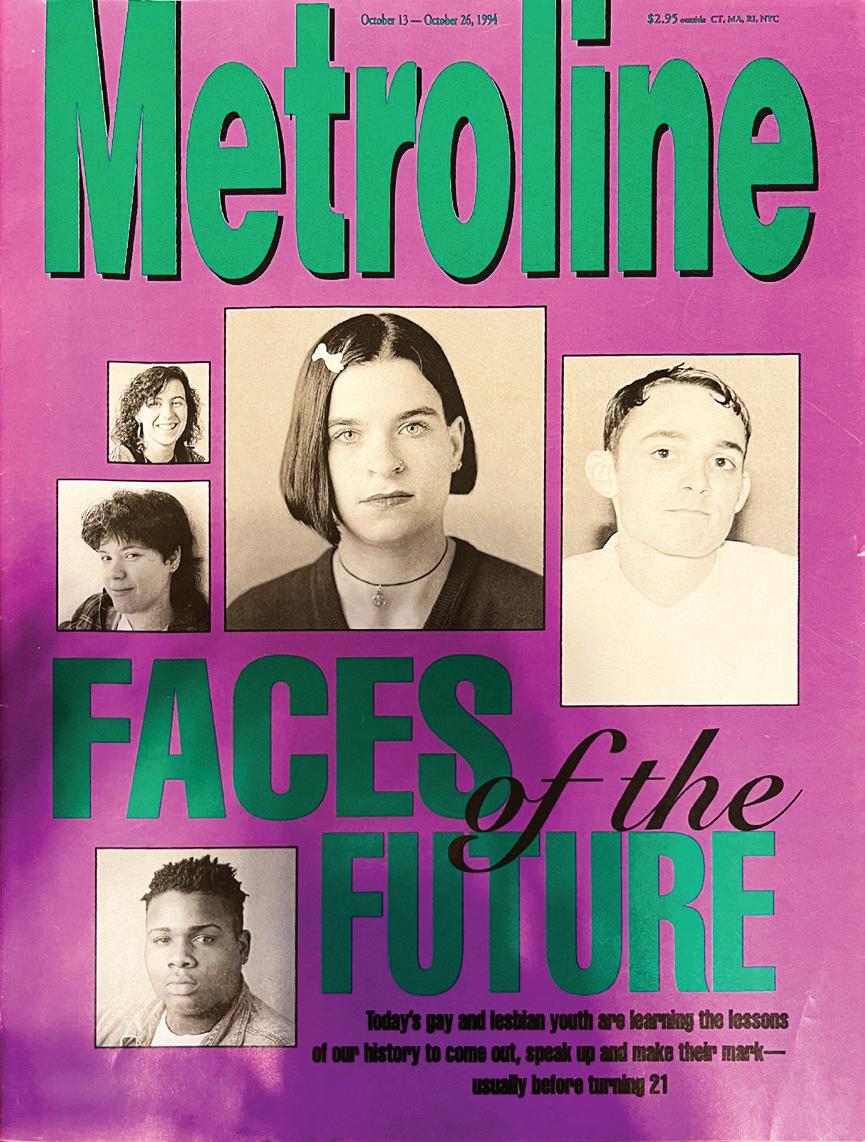
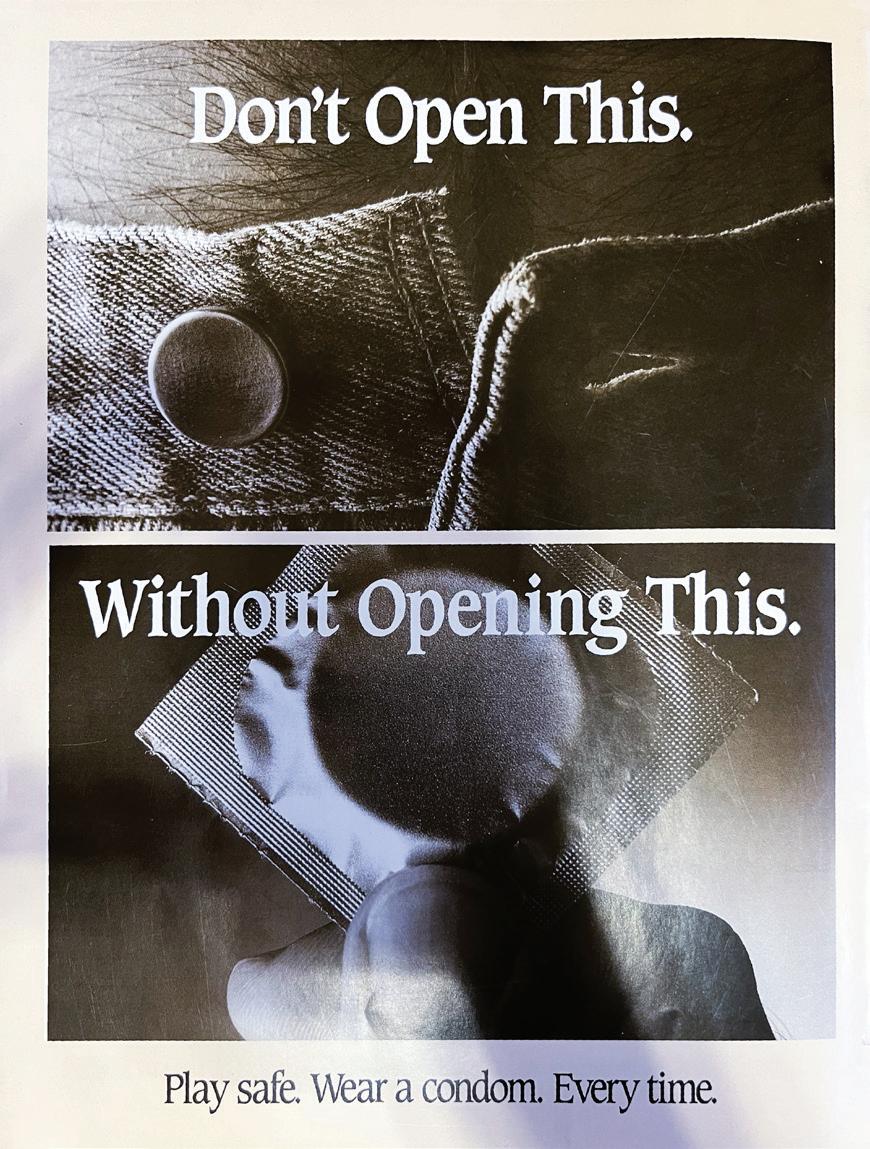


25 March 2023
Counter Memories
Three front covers and one back cover of the Metroline magazine. Photos courtesy of Jabez Choi.
We continue to talk—about the man’s partner, about our own partners, our own histories. At that point, I stop taking notes. There is no need. I remember the night clearly. We had shared secrets and now, I can only write so much.

26 TheNewJournal
Counter Memories
Partners Cafe.
At the same time, Metroline writers envisioned brighter futures. An op-ed in a 1994 issue by Larry Kirk titled “THE YEAR OF QUEER” reads: “It is through such actions that our movement will ultimately prevail, that the world will be made safer for a new generation of gay boys and girls. If this can happen in 1994, it will indeed be the Year of the Queer, no matter what else may, or may not occur.” The magazine attempted to immortalize turbulent and frustrating moments. But, the pages are yellowed. They carry a faint scent of dust. The advertisements and pictures look inexplicably off-kilter, an estrangement only time can inflict.
Seth’s face changes, just slightly, after he sips his drink.
“What about the people that aren’t here?” He says, his voice eases. “They have got no clue of understanding, all the sacrifice and all the commitment to equality that went down to create this, to bring it to fruition.”
The next night, I talk with Bryan. He works behind the counter at 168 York some nights. He doesn’t like the title “bartender,” though. Making drinks is a gig he fell into by happenstance. A few years ago, Bryan walked into 168 York on a whim. He sat by himself at a table by the windows. Across the room, Joey played setback with some friends. Bryan watched, then eventually joined. They would play together every week for two years. One day, a bartender position opened, and Joey hired Bryan on the spot.
“He looked to me like, you’re gonna be my new bartender. I said ‘No, no. I’ve never done this before,’” Bryan says. Then, jokingly: “It just kept happening. I can’t get out of it. I can’t make it stop!”
Bryan says he is at a strange age, describing himself as being “right in the middle.” He didn’t live through the AIDS epidemic like the generation before him. But he says he wasn’t exactly marked by the “acceptance” that seems to define the current generation. He remembers growing up with stories of Matthew Shepard, a gay student at the University of Wyoming who was killed in 1998 as a result of an anti-gay hate crime. He still remembers when political parties across the spectrum all opposed gay marriage. Now, he notices the stark differences.
“I cannot just so unapologetically go to any bar I want to with a boy and feel comfortable kissing that person,” he says. “You feel comfortable kissing everyone until you do that in the wrong place. You don’t understand the importance of having a safe place. And why gay bars are so in need of being protected as safe spaces.”
As he talks, I notice that remembrance for Bryan is significant. He takes pride in remembering this past era. Certain traditions he still upholds with other bar-goers. Inside gay bars, Bryan calls his friends “Mary,” after a practice in the 80’s and 90’s of men calling their partners “Mary” to obscure the fact that they were seeing men. Inside the bar, Bryan only responds to feminine pronouns. Though this practice
started off as a protection measure, Bryan reclaims it as a method of remembering queer culture.
“Why do we do that? I’m using these pronouns in a different capacity because that’s what historically what we built on, from the raiding of bars,” he says. “Was I a part of that? No, I wasn’t a part of that. Do I know a little bit of that history? Do I want to keep some of those things alive? Absolutely.”
“This is your way of remembrance,” I say.
“Absolutely. How do we move forward from that, while still acknowledging and respecting by maintaining our culture?” he says. “Are you looking at America? Like, where are we going right now? We’ve already done all this stuff and now we’re going back because we’ve forgotten what we’ve already done.”
When he finishes, Bryan leaves me to tend to a regular, a man in a checkered shirt. As he pours a drink for the man, he asks where the man’s partner is. Before he can answer, Bryan asks if they had been fighting again. The two laugh. Bryan introduces me to the man. I also ask where this man’s partner is. We continue to talk—about the man’s partner, about our own partners, our own histories. At that point, I stop taking notes. There is no need. I remember the night clearly. We had shared secrets and now, I can only write so much.
In a corner room at Partners, I play pool with a stranger who is old enough to be my father. I don’t call him my father, but I imagine that he is to feign some intimacy. It is a close game, only because we are both bad shots. In between turns, we talk. He is an artist from New York, but whenever he is in town, he stops by Partners for a drink. In the end, he beats me by just one ball. I’m lucky we haven’t bet on anything.
“You’re supposed to be better than me,” he says, laughing. “I’m all old now.”
He grabs his quarters and his bag. Before he leaves, though, I ask if I could see his art. He spreads his notepads across the pool table. They are worn. One by one, he shows me his drawings, each a sketch of a previous lover. Or a friend. Or a lover of a friend. They are all nude. He tells me how he fell in and out of love with one of the naked men. And as he talks, I realize the man misses him. Some of these men, he still visits back in New York. Others have since died. He doesn’t mention anything more. His eyes soften on the pages.
It’s karaoke night. In the background, a man sings “Bad Romance.” He’s impressively offkey. A group of people laugh. They all clink their glasses. I stay for a few more minutes, humming along to the Lady Gaga song. The man reaches the final chorus, and people begin clapping. I leave soon after. Walking down Crown Street, I shiver. It has suddenly become cold. ∎
27 March 2023
Counter Memories
Jabez Choi is a sophomore in Trumbull College and an Asociate Editor of The New Journal.
Local advocate Tony Ferraiolo guides trans youth—and their parents— through the complications of their gender journeys.




28 Snapshot
layout design by Etai Smotrich-bArr &
TheNewJournal
Kevin Chen
By Hannah Szabó

n carefully-labeled boxes in her study, my mother preserves my childhood drawings, schoolwork, and journals. Early attempts at academic writing sit inside the Hannah: 2015-2016 bin (“You may just think of Susan B. Anthony as the woman on the silver dollar coin, but she was much more than that”). Hannah: 2013 holds a hand-drawn comic book based on the Clue board game. The boxes before that, dating back to before my transition—all labeled with my birth name—include an evolving set of colorful self-portraits. Each drawing was an attempt to communicate who I was to the world. Each was crafted in Tony Ferraiolo’s Saturday morning drawing group.
Every other weekend starting at age six, I would walk into the location of Tony’s drawing group in my school clothes. Solemnly, I’d change in the bathroom into whatever feminine outfit I had most recently bought from a secondhand store in Hamden. Sitting around a table covered with scraps of printer paper and loose magic markers, I’d make art with a group of other gendernonconforming kids from around the greater New Haven area. Tony would give us instructions: “How many of you have been sad about how you relate to your body? Draw it.”
As a kid, I just knew him as the bowler-hat wearing, tattoo-covered guy who ran my loosely-defined art class. But Tony wears many other hats: founder of the Jim Collins Foundation, which provides funding to trans people across America for gender-affirming surgeries; director of the youth and family program for Healthcare Advocate International, a Hartford-based educational and medical organization; guest speaker at countless corporations and groups across Connecticut—a self-described “professional trans person.”
When I began attending Tony’s classes, I never really wondered how or why the program started; I took it for granted that resources like these were available to me. But Tony founded the group in 2008, only a year before I joined. What he offers is a comprehensive but casual program that allows children to express themselves creatively, and, through a simultaneous parent
group, provide practical and emotional advice. Through this twofold structure, Tony helps families make sense of their role in their child’s gender journey.
The group evades bureaucratic categorization; it is not housed under any umbrella nonprofit, and there is no official name. He even avoids describing the group as his own: “I knew from the beginning that these are not ‘my’ groups, but the members’ groups,” Tony explained to me over email. “We don’t have an agenda or a certain subject that the members have to talk about. The support groups are free flowing.” Members can choose the creative activity that they do on a given day, and are free to direct the conversation in whichever direction they please.
gender-nonconforming youth and their parents.
A lack of conventional publicity has not prevented Tony’s group from expanding, however. Fifteen years after its founding, the program is thriving, with dozens of kids and families attending each week. When I started attending as a first-grader, I was one of the youngest, shyly watching the teenagers joke around in the room next door; now, there are facilitators and ‘junior facilitators’ (past members who have aged out of the program and want to remain involved) who help Tony manage the larger number of kids. He has split the group into three simultaneous sessions with different activities based on age: drawing time for those under nine, and discussion groups for pre-teens (ten to twelve) and teenagers (thirteen to eighteen). For the last hour of each session, everyone joins together to play board games and socialize.
This independence from a larger institution is part of what has allowed Tony’s classes to continue for so long; activities hosted by the New Haven Pride Center, for example, have been hampered since the nonprofit lost its 501(c)(3) status for a few months this year after failing to file tax returns. Tony’s group, on the other hand, does not rely directly on institutional support; he offers the Saturday morning meetings pro bono, paying for the craft supplies out-of-pocket. Locations in and around New Haven allow him to use their spaces at no expense for him or the families who attend.

Perhaps this casualness is part of why kids like me found so much comfort in the group—it stands apart from well-intentioned but stiff LGBTQ+ info groups at medical centers and GayStraight Alliances at high schools, spaces that make self-conscious attempts to tout institutional support but end up stifling vulnerable discussion. But the fact that Tony’s group is separated from larger support structures means that the support it offers remains elusive to those not already within the system. No Google search will lead one to this group; it is a resource that travels through the elaborate social network of

During the years when I was a member of Tony’s class, we bounced around between three locations. Since then, the group has settled down in one place. Tony keeps the meeting location private, he told me when we met in a cafe one February morning, to pro tect the members of the group. “We have people who hate us.”
hen I asked my mom how we first learned about Tony’s group, she described a convoluted chain of contacts. Since my kindergarten days, we had been part of a series of informal groups focused on gender-nonconform ing children: a mailing list for parents to share resources (known by its subscribers simply


additional illustrations by charlotte rica
Left: “Viotinah Szagah,” 2011, Hannah Szabó, age 8. Made in Tony’s drawing group, labeled with an elaborate reimagining of my birth name.
Left: Hannah Szabó
/
The New Journal
March 2023
as ‘The Listserv’); a group in New York City that we attended a couple of times during my second grade year; an annual summer family gathering known as Camp I Am. One early liaison from these networks was Edgardo Menvielle, a Psychiatrist at the Children’s National Medical Center in Washington, D.C., who put us in touch with a local contact who in turn connected us with Tony.
Others seem to have found out about Tony’s group through similarly convoluted means. As I started working on this article, my mother forwarded me
a few of the emails she had received over the last decade from parents of gender-nonconforming youth. Searching through the archives of her inbox, scrupulously sorted just like my childhood artwork, my mom had located dozens of email chains with parents from around Connecticut. Some had gotten her contact information from mutual friends; others knew to reach out to her because they had received an email sent to my whole elementary school when I transitioned; still others were referred to her by local clergy or physicians who
had worked with our family. The parents who reached out to her seemed unable to find these resources on their own; one 2016 email sent to my mom from a parent of a student at my elementary school read, “Do you know of any social support groups for preteens? I’ve reached out to a couple LGBT groups and haven’t heard back. We are trying to find anything near New Haven that would be welcoming.” A similar email came from a member of our synagogue; another was from a professor who had just moved to town. At the end of each


30 March 2023 TheNewJournal
Drawing it Out
“My Self Portrait,” 2009, Hannah Szabó, age 6. Made in Tony’s drawing group.
chain of correspondence, she would send the concerned parent Tony’s contact info. “He is the connector who holds the community together,” she wrote in one email.

This elaborate network of referrals makes it difficult to trace the origins of Tony’s group—only Tony himself can explain how it began.
hen I arrived five minutes early to scout out a table for my meeting with Tony, I found him already there, sitting by the window. He was the same as I remembered him, beard combed into a
triangular point, arms covered in a sleeve of tattoos that featured, in black lettering on his right arm, the phrase ‘CREATE YOURSELF.’ I, on the other hand, was ten inches taller and six years into hormone replacement therapy. He looked up with a smile, exclaiming, “You’ve gotten older!”
When Tony started the group, he explained, it was easier to find. He announced the proposed meeting times and distributed fliers at True Colors, the annual LGBTq+ youth conference hosted on the University of Connecticut Storrs
campus. At Tony’s first class, only two kids showed up. “One of them, Angel, did the same thing you always did,” Tony laughed, recalling my outfit swaps. “She went to the bathroom and changed into what she wanted to wear. And that’s when I knew that this could really be space to feel comfortable in your skin, create, and be yourself.”
Before 2011, when “gender identity or expression” was added to Connecticut’s list of legally protected categories, there was no requirement that schools respect the identities or

31 TheNewJournal March 2023
Drawing it Out
“Jonah,” 2008, Hannah Szabó, age 5. Made before I joined Tony’s drawing group, in kindergarten.
needs of gender-nonconforming and trans students. And it wasn’t until 2015 that Yale Health’s Gender Program, a centralized source for trans healthcare in New Haven, was established. Facing a lack of social and medical resources, many families with trans or gender non-conforming children turned to Tony for his familiarity with these issues, and ended up attending his support group.
Even nonprofits and medical services that were nominally offering support for queer youth began to refer their patients to Tony, unsure of how to help them navigate other parts of the bureaucracy. “Pretty soon organizations all around Connecticut were contacting me,” Tony said. He would receive open-ended requests from overwhelmed therapists and doctors, who knew him from his public speaking and nonprofit involvement: “We have a seven-year-old, we have a nine-year-old, we don’t know what to do,” Tony recalled them saying. “Can you help?”
The group quickly grew from there. Now, Tony finds publicizing the group unnecessary. He explained that people just know about him, as we had, through the natural social fabric of the LGBTQ+ community. “I always get emails that say stuff, like, ‘a friend of a friend knows a parent that goes to your group,’” described Tony. “Barely anyone knows my last name. People just say— oh, there’s this guy, you know Tony—oh yeah, I know Tony!”
ony’s strength lies in his ability to simultaneously offer practical and emotional support. When families ask for advice about legal or medical services, he is already familiar with the specific laws and systems that govern Connecticut. When a child is unsure about how to express themselves in words, he sits with them and has them draw pictures. And when he needs to help a hesitant parent come around to accepting their child, he meets them where they are.
Tony described one recent interaction on the phone with the father of a child who had come out as trans: “He was dropping the F bomb, cursing his kid out. I said, well, is there any selfharm or any suicidal ideations going on with the kid? ‘Oh yeah. He tried to kill himself three times.’ So I said, let me ask you a quick question. Do you want to accept your son or mourn your

daughter? Because there is a likelihood of you standing in front of that grave saying, shit, I should have called you Chris this whole time.”
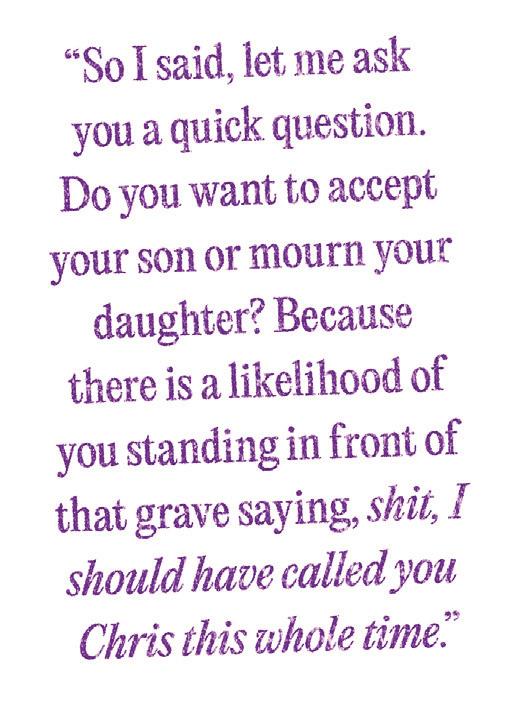

Tony has seen these stories, all-toocommon in the trans community, play out around him; he has witnessed firsthand the effects of children feeling alone. “A few years ago, I was visiting a psych hospital to see a kid When he saw me, he smiled so big. To me, it felt like at that moment in my life, I was responsible for all these lives.” The burden of providing a child with the love and acceptance that their parents had withheld left Tony physically incapacitated. “My blood pressure went sky high. I had to go to the emergency room.” Tony took a yearlong break from life coaching after this incident.
community, it is these relationships Tony crafts and facilitates that most powerfully transform the lives of those around him. “That’s what I’m here for,” he told me. “I’m here to talk it out.”
When I was around nine, I asked Tony to start having one-on-one meetings. I had started to become aware of an identity being forced upon me that felt deeply wrong. During music and gym time, we were now split into “boy” and “girl” groups; in Spanish class, my grammar started to be corrected when I resisted using the masculine ending -o to describe myself. Amidst these curricular shifts, I grappled with the fact that my body was soon going to change in ways I wasn’t sure I could deal with. But I lacked the words to describe exactly what it was I wanted to say.
Tony and I would meet every month or so, on weekday evenings in his Hamden apartment. The walls of his living room were decorated with his own art—abstract and tactile, loose brushwork and dripping colors. It was here in this private space, sketchpad in hand, that I first articulated through drawing that I was transgender. When I didn’t want to talk it out, Tony and I would draw it out. ∎
Helping a child navigate their own gender identity thus requires a complex combination of buy-in and detachment from parents. “I don’t think people realize this enough with kids,” Tony posited, “but no one knows who they are better than they do. I tell parents all the time, allow your child to walk their journey. You just protect them. They know who they are.”

Tony described the types of language he frequently uses with hesitant parents. “I’m not trying to talk you into anything. The only thing I’m trying to do, because of the love you have for your child, is make sure you have a good relationship with them, support them.”
Beyond the myriad of concrete ways he contributes to Connecticut’s LGBTQ+
On June 10th at 6:30, at North Branford High School, his alma mater, there will be a tenth-anniversary screening of the documentary A SelfMade Man, a film by Lori Petchers about Tony’s life and his work with transgender and nonbinary youth and their families The event will benefit Q+, a queer youth organization in Hartford, tv-365, a non-profit organization serving the transgender community, and North Branford High Schools Diversity Group.
32 March 2023 TheNewJournal
Hannah Szabó is a sophomore in Pauli Murray College.
Drawing it Out
Kissing One of Your Queer Awakenings
11/28/22
I had a dream about you last night. In the dream, I was at a party that happened to be yours. And in the dream, I wanted to avoid you but pick up something you had made before I left.
The night before you left, we sat in your old red pickup truck, or rather you sat on my lap in your old red pickup truck and you were strangely persistent about returning a small gift I had given you. Before kissing me.
The first time I wanted to say hello to you was in middle school when you were both what I wanted to be and who I wanted to be with. Maybe it was only one of those, maybe it was both. I still don’t know. But I was happy to have you as something to think about.
High school came around and our first bad relationships had ended. And our mutual friend wingman’d us together until we became “definitely better than my first relationship” to each other.
Until we got sunburned from sitting in a muddy apple orchard. Until you were saying you’d show up to my high school on my birthday with a present and a lunch date. Until we drove back to our middle school where we walked, you close to me, in the pitch black you were afraid of, to look at racing meteors that we would never have been able to see. Until we got tired of sitting under our middle school tree. Until we walked back to your old red pickup truck where you sat on my lap and gave me back the thing that would’ve made you feel guilty to keep.
I don’t love you. I think I never did. And you knew that you never loved me, you just liked how I treated you. And that’s okay now. It has been for a long time.
We never said goodbye. You just said you were sorry to tell me like this over text. You returned my hoodie two days later. The one with my last name written on the back that you wore at school while we were together. We never said goodbye. You just watched the red pickuptruck hickey I left on your neck fade over the following days. And knowing that I’d left you with something that called for an explanation to my also fading friends at your school, That no one knew who you were at my school, was pettily satisfying to me.
We never said goodbye. We just pass each other in the street of our little town, pretending we never said hello to begin with
Adrian Elizalde
33 TheNewJournal Poem
Waiting for Care
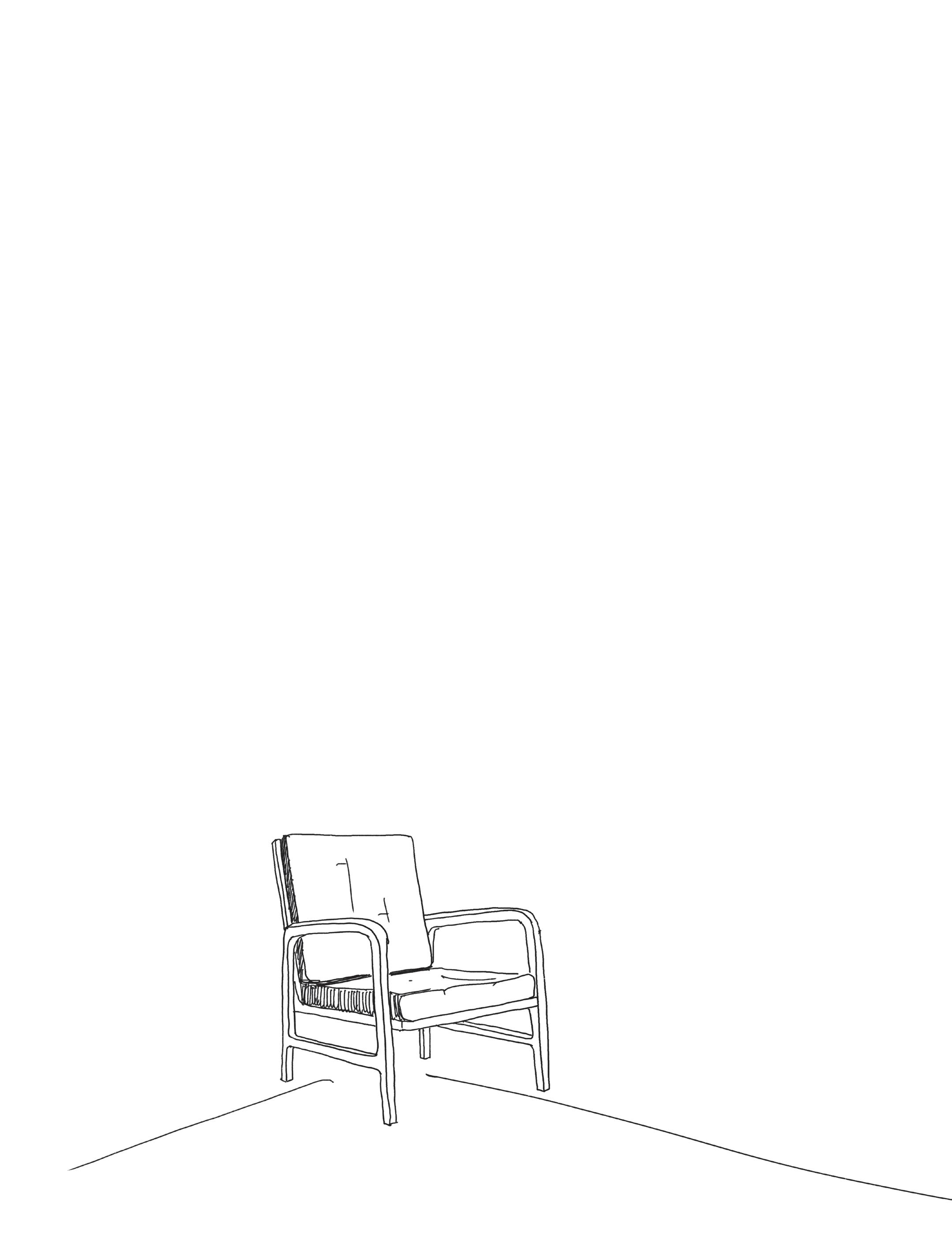
the
Pediatric Gender
By Theia Chatelle and Iz Klemmer
34 TheNewJournal
At
Yale
Program, trans kids say they receive great care—but it’s not easy to get.
LAYOUT DESIGN AND COVER ILLUSTRATION BY KEVIN CHEN INSIDE ILLUSTRATIONS BY CHARLOTTE RICA

35 March 2023
BEGINNINGS
On the night of August 17th, 2022, Dr. Christy Olezeski received a Twitter notification. Then another, and another. She was on vacation with her family, taking a break from New Haven and the pressures of her work as Director of the Yale Pediatric Gender Program (YPGP). She hadn’t even brought her work laptop with her—her goal was to unplug. But, as the Twitter notifications streamed in, she realized something was wrong. The world had found her.

Dr. Olezeski, affectionately known by her patients as just Dr. Christy, knew it was only a matter of time. Right-wing activists had launched threats targeting Boston Children’s Hospital earlier that same month, and the year’s legislative sessions had seen a slate of anti-trans bills passed in Texas, Alabama, and Idaho. Dr. Olezeski hadn’t been deterred— but when she saw that Libs of TikTok, a right-wing Twitter account with over a million followers, had reposted a video of her from the YPGP’s website, she knew the YPGP was in danger.
“I give it twenty-four hours before I get my first death threat,” she thought to herself. The next morning, Dr. Olezeski woke up to four emails she described as “quite unpleasant.” Within two days, the story was picked up by international conservative media outlets including Fox News, the New York Post, and the Daily Mail. “Yale professor blasted for program working with 3-year-olds on their ‘gender journey,’” read Fox News’ headline. More emails streamed in, and phone calls and letters began arriving at the clinic. Some of Dr. Olezeski’s harassers even found her home address, sending letters directly to her house. Dr. Olezeski was the face of the YPGP, and so far-right media outlets and influencers like Libs of TikTok descended on her as an emblem of “gender ideology,” a term used in transphobic politics which presents the existence of trans people as a threat to society. In total, she and the clinic received hundreds of threats.
As Dr. Olezeski sat in one of the clinic’s sterile conference rooms, recounting the harassment on a cloudy afternoon last February, she took a deep breath. Then she took another, and then another. And, finally, she began to cry. Dr. Anisha Patel, one of the co-founders of the YPGP alongside Dr. Olezeski, hugged her. “We’re huggers here at the clinic,” Dr. Patel affirmed. Dr. Patel sat back down, but Dr. Olezeski began to cry again, so Dr. Patel returned for another hug and continued to sit by Christy’s side. The two took a moment to collect themselves, and then Dr. Patel emphasized that, after the threats, “the support came from the team. We were always pretty close, but now we’re like a little family.”
The Yale Pediatric Gender Program started with an email. In 2014, Dr. Olezeski was working in the Department of
Psychiatry at the Yale School of Medicine (YSM). After speaking with trans community leaders in New Haven about the needs of the trans kids they worked with, Dr. Olezeski emailed the Department of Endocrinology to ask who was providing healthcare to trans youth. The response was concerning: Yale had no such program. Luckily, there were other interested doctors in the pediatric endocrinology department at YSM, including Dr. Patel.
Prior to 2014, Dr. Patel had the occasional trans patient but lacked the infrastructure to do anything but refer them to hospitals in Boston and Hartford. One patient of hers lacked the resources to make it to either city. “I don’t have anywhere to go,” she remembers the patient telling her. “You’re my doctor, and I want you to do this for me.” Dr. Patel looked him in the face and made a promise: “I will figure this out.”
With the addition of Dr. Susan Boulware and Dr. Stuart Weinzimer, both pediatric endocrinologists at Yale, the Pediatric Gender Program team officially numbered four. But before they could open their doors, they had to research. The team contacted academic pediatric gender centers across the
36 TheNewJournal Waiting for Care
Dr. Christy Olezeski, Director and co-founder of the Yale Pediatric Gender Program (ypgp ).
Photo courtesy of Christy Olezeski
country, discussing policies and procedures. The four doctors met monthly for a year to assemble their team. They recruited endocrinologists, psychologists, psychiatrists, an OB /GYN, an ethicist, and a lawyer. Every team member worked on a volunteer basis.
“We knew it was going to take a long time to go through the regular channels at Yale,” Dr. Olezeski said. But trans kids were in desperate need of care, and they had nowhere to go in New Haven. The team decided on a work-around: one halfday a month, the three endocrinologists would take on gender patients instead of their general endocrine schedule. The clinic officially started taking patients in October 2015. “There was no ribbon cutting,” Dr. Christy laughed. “It was all word of mouth in the beginning.”
But word of mouth traveled fast: wait times had ballooned to eight months by 2017. Soon after, wait times were measured in years. The team petitioned Yale New Haven Hospital (YNHH) for support, and, in 2018, they were able to begin providing gender-affirming care for one full day per week. During the pandemic, they added clinics on the first and fifth Thursdays each month, growing to their current total of nine to eleven clinics per month. As of 2023, they provide services in New Haven, Trumbull, and Old Saybrook. To date, the YPGP has provided care to 425 people. But as more states across the country have adopted hostile attitudes toward trans teens, demand for the clinic’s services have grown, with patients streaming in from places as far away as Florida.
2020 was a difficult year for LGBTQ+ youth. 2021 was worse, and 2022 was no better. As of March 10th, 2023, bills have been introduced in 22 different state legislatures to criminalize gender-affirming healthcare. Recently, both Tennessee and Mississippi passed bans on gender-affirming healthcare for minors, and several other states, including Texas, appear poised to be next. While Connecticut has reaffirmed its commitment to the legality of gender-affirming healthcare, Dr. Olezeski still worries. “While yes, Connecticut is lucky to be in a place where there aren’t attacks actively happening, but it seems like the climate is still dangerous,” Dr. Olezeski said.
But the harassment Dr. Olezeski and the YPGP faced last summer has only strengthened their commitment to the trans community. “We’re not stopping and we’re just going to continue to grow,” Dr. Olezeski emphasized. “It’s made our team stronger, I think. And so we’re not backing down.”
ROWAN
On the eleventh of every month, Rowan gets a calendar notification: “record voice update video.” With his catalog of monthly videos, he can look back and trace the changes in his voice, an effect of the testosterone he’s been taking for the last
year. “As someone who does a lot of singing, I started as a mezzo-soprano and now I’m a bass baritone,” Rowan explained. “That’s super, super cool.”
Rowan is fifteen years old, from South Windsor, CT. He loves Deftones, plays the guitar, and is excited about his upcoming role as Pugsley in his school’s production of The Addams Family. He’s also a patient at the YPGP
When Rowan was thirteen, he told his parents he wanted to start testosterone. His voice dysphoria was so bad that he struggled to talk and didn’t want to leave the house. He had been questioning his gender since he was eleven, and he was finally sure that he wanted to pursue gender-affirming care. “I felt very guilty that I was kind of breaking their expectations of me,” Rowan remembered. Despite his anxiety, his parents were accepting from the beginning, and they were eager to meet his needs. They knew his quality of life was at risk.
In late 2020, Rowan and his parents got to work finding a clinic. Rowan’s parents called the YPGP, and they were lucky: when they called, the waitlist for an appointment was only three to five months. When the day of the appointment came, Rowan and his parents loaded up the car and drove for an hour to get to New Haven. He remembered being a little nervous but “very excited to see where it was gonna lead me.”
The YPGP was an instantly comforting space for Rowan. “It felt like they’re kind of a family,” he said. Even though it was a doctor’s appointment, it felt like a casual conversation where he could express his needs. After Rowan explained what he needed out of the clinic, they explained the options they had available for him. Rowan left his intake appointment with a prescription and a new outlook on life. “My confidence skyrocketed.”
Now, one year later, Rowan returns to the clinic every few months for follow-up appointments. First he meets with Dr. Boulware, then Dr. Olezeski and Dr. Patel. Rowan also meets with clinical psychology Ph.D. student Wisteria Deng to have a one-on-one conversation about his mental health and wellness.
In 2022, Rowan found out about a unique opportunity from the clinic’s mailing list: a circus workshop for trans kids. Rowan participated for a few months that summer. “It was a really fun experience,” he said. The workshop was a space to learn skills ranging from juggling to walking balance beams, and doctors participated right alongside the kids. Even Dr. Olezeski picked up a new favorite party trick: she can now balance a peacock feather on her hand.
At the Yale Pediatric Gender Clinic, Rowan has found more than just medical care: he’s found community. The YPGP changed Rowan’s life, and he knows it. “I’m very grateful that I have this privilege,” he acknowledged. Rowan’s case, however, is frustratingly rare. For many trans kids in New Haven and across Connecticut, access to care remains locked behind a waitlist and a multitude of structural barriers.
37 March 2023 Waiting for Care
For many trans kids in New Haven and across Connecticut, access to care remains locked behind a waitlist and a multitude of structural barriers.
JUDE
Jude Arnott was referred to the YPGP in 2019 after he was hospitalized at the Yale New Haven Psychiatric Hospital. Jude, fifteen years old at the time, struggled with overwhelming emotions and didn’t know how to cope. He struggled with outbursts, aggression, and suicidal ideation. He would later realize that many of his struggles were the result of gender dysphoria, which he had struggled with for years. When he found himself back at YNHH in 2019, the doctors on-call recommended he make an appointment with Dr. Olezeski at the YPGP. So he tried. And tried. And tried.
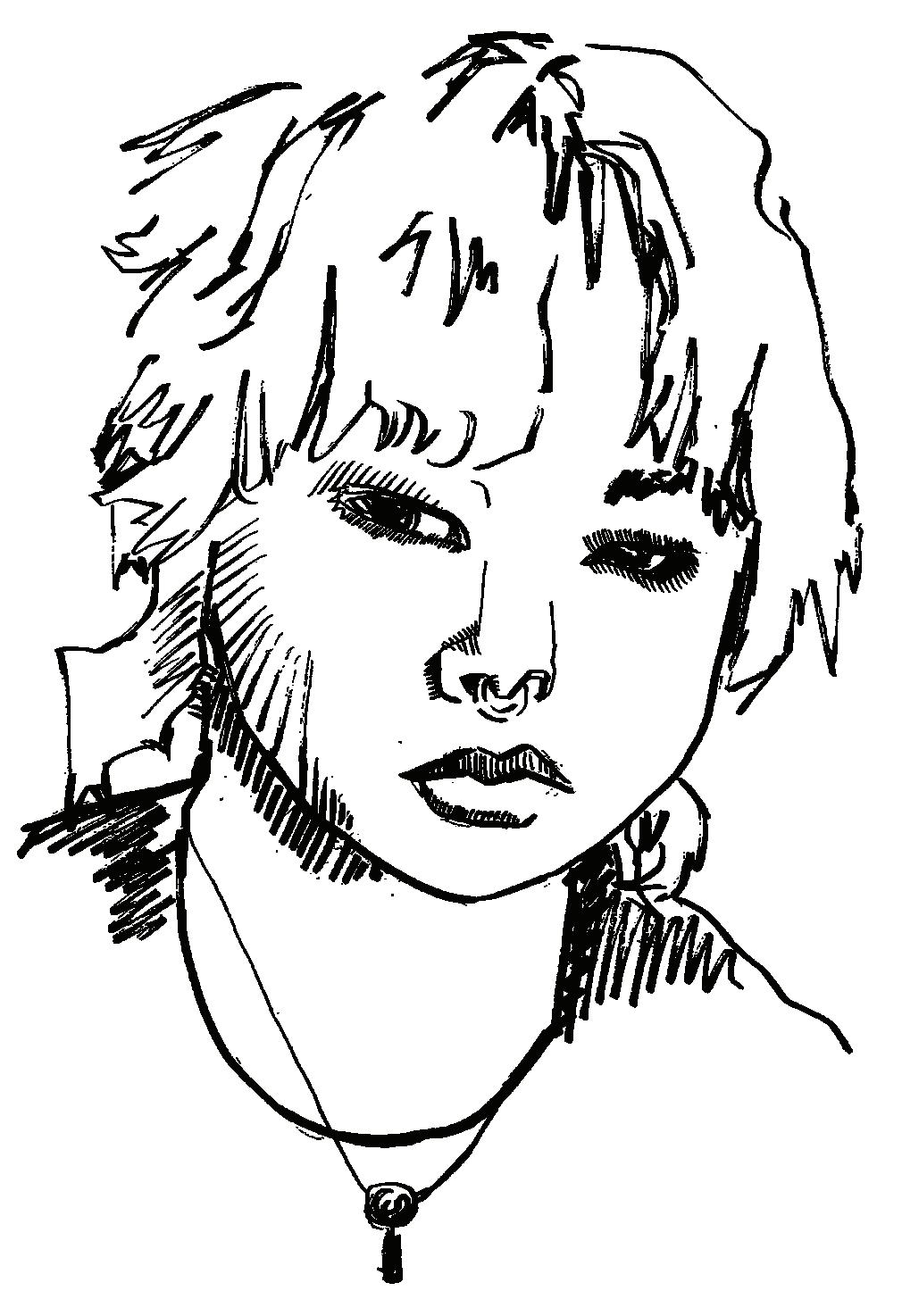
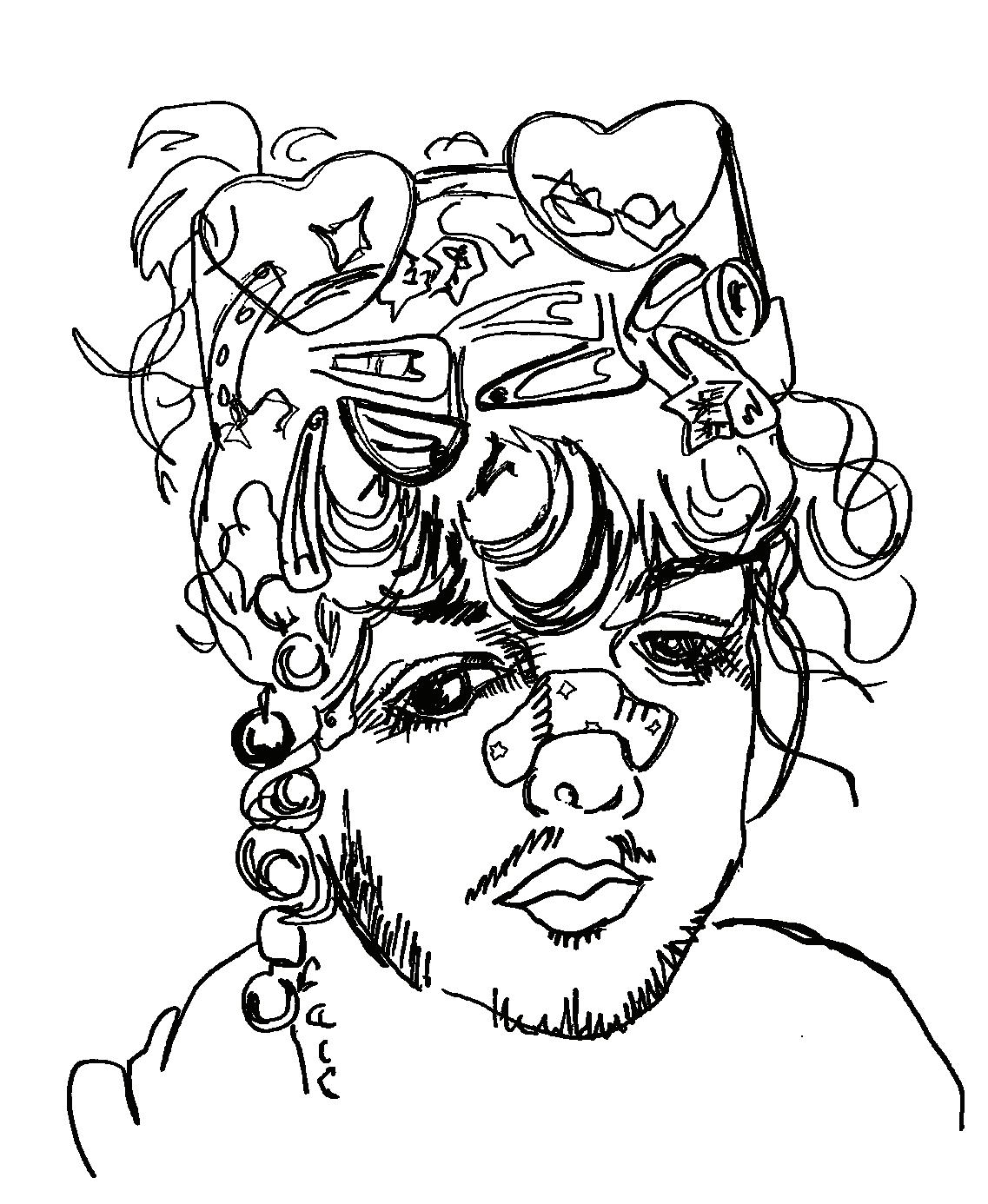
When Jude told his parents in 2015 that he wanted to start to socially transition, his parents didn’t bat an eye. “I am one of the luckiest people,” said Jude. “My parents have health insurance, they were supportive, and I was in a place where I could
get gender-affirming healthcare.” But as Dr. Olezeski stressed, for every person like Jude, there is at least one teen who wants to transition, but doesn’t have parental support or the financial resources to do so. “I worry about those kids,” said Dr. Olezeski. Jude was placed on the YPGP waiting list. The YPGP told him and Kathleen, his mother, that it would be at least three years until he could be seen for an intake appointment. But Jude was in need of immediate attention: he was in and out of the hospital, and his relationship with his brother and parents was under strain, punctuated by fights despite their support. He required treatment immediately, but the YPGP simply didn’t have the capacity. Jude and his parents had to look around for the next best option.
While Jude’s decision to leave the YPGP’s waiting list was quick, the process of finding other care was difficult. At first, Jude saw a gender therapist in the New Haven area. After six
38 TheNewJournal
Waiting for Care
Illustrations of Rowan (left) and Jude (right).
months, he received a letter of written support from his therapist attesting to his need for treatment—these letters are a necessary first step toward beginning gender-affirming treatment at many clinics. He also obtained a referral to the Connecticut Children’s Medical Center’s Gender Identity Program (CCMC). Letter in hand, he and his family called CCMC to schedule an appointment. The process was quick: after his first visit at CCMC, Jude was prescribed puberty-blocking medication. A doctor placed an implant in his arm, and shortly thereafter he began hormone replacement therapy.
Jude also attempted to get “top surgery,” a masculinizing bilateral mastectomy, from a surgeon at YNHH. According to Kathleen, the surgeon’s staff refused to update Jude’s legal name in their system, which she says led to them deadnaming Jude— referring to him by the name on his birth certificate that he no longer identifies with—over twenty times. Kathleen struggled with Anthem, her insurance provider, whose coverage of gender-affirming surgeries does not typically extend to minors. And then, after a year and a half of waiting, she received a call: the surgeon had retired, and the surgery was canceled. The surgeon’s office didn’t return a request for comment. At the age of 15, and long after the ordeal at Yale, Jude was finally able to receive top surgery at CCMC. “It was tough for him, but if there’s one thing about Jude, if he wants to do something, he’s going to do it,” said Kathleen.
Families’ relationships with the YPGP differ, and wait times can vary widely from year to year. While Rowan was lucky enough to avoid the YPGP’s growing waitlist, Jude was never able to schedule an appointment despite an inpatient psychiatric referral. Oftentimes, a family’s experience with the YPGP is driven by factors outside their control. Insurance policies, distance between the clinic and a family’s home, and the support (or lack of support) parents show for their child all influence a family’s ability to find treatment. But for trans teens, time is ticking. With every passing minute, they’re going through puberty—the wrong puberty—and undergoing the unwanted, irreversible physical changes this puberty brings on.
ALEX
Alex, an eleven-year-old in New Haven, could be described as a free spirit. She refuses to conform to society’s expectations of what a boy or girl should be. She likes to experiment: with her uniform at Elm City Montessori, her name, her pronouns. She’s obsessed with Disney’s Frozen: according to her mother, Jessica, the movie was a formative part of Alex’s gender journey. Jessica and her wife didn’t think much of it at the time. “We were like, Alex is a kid who loves long hair, loves princesses, and loves powers. That kind of thing.”
As Alex grew, she felt limited by her peers’ expectations of her. She didn’t want to be a boy. She didn’t want to be a girl. But after talking with her parents, she decided that, if she had
to be one or the other, “I choose girl,” she said. For Jessica, “the pressures are still there to call certain behaviors girl behaviors and others boy behaviors.” Even though, as Jessica was quick to point out, East Rock and New Haven are welcoming places to be trans, there are still biases and uncomfortable situations that Alex has encountered. For example, at school, there were only boys or girls uniforms for her to pick from. This is something that Jessica admits Alex will have to live with, but “so far, she’s doing a great job.”
In late 2021, at the urging of their pediatrician, Alex’s parents decided to schedule an intake appointment with the YPGP. They were informed that the wait time was thirteen months. But Alex had time. She hadn’t started puberty, and while the wait was long, it was something they were willing to put up with. The quality of care at the YPGP made the wait worth it, Jessica had heard. So as long as Alex was fine with the wait, there was nothing to lose—until they received another call from the YPGP. Alex’s appointment had been canceled, and they would have to reschedule for another thirteen months later. That was enough for Jessica. “There’s this feeling that maybe they’re providing great services, but if my kid can’t get them, that makes me mad.”
To meet the demand of their current waitlist, the YPGP needs to add more clinic time and hire more doctors. With appointments that average ninety minutes, they need more time than most endocrinology providers. However, the YSM administration has been pushing back on their requests for more resources. “When there’s limited space, they’re gonna say, ‘No, we don’t want you to open another gender clinic, we want you to open up a general endocrine clinic, because short kids need to be seen too,’” Dr. Boulware said, referring to cisgender kids who need support for atypical puberty. But there are dozens of endocrinologists treating cisgender kids in the New Haven area, while the YPGP is the only program serving trans kids.
As a stopgap measure to help those on the waitlist, the YPGP provides events and community to any trans kid in the area. Dr. Olezeski first started a parent support group and then expanded to a youth group. She offers the events to anyone on her mailing list as a way to provide outlets for trans kids to connect with other trans kids.“We’ll try to get them involved in these other things to sort of have that community and support,” she said.
But supplemental programming can only go so far when patients are waiting two years to be seen. “We’re just asking for more money. Continuously more money,” Dr. Olezeski explained. “More money to hire more people.” Without institutional support, trans kids like Alex will continue to stare down extensive wait times at the expense of their physical and mental wellbeing. ∎
39 March 2023
Waiting for Care
Theia Chatelle is a sophomore in Hopper College. Iz Klemmer is a sophomore in Saybrook College.
“...maybe they’re providing great services, but if my kid can’t get them, that makes me mad.”
We will live in a corner house.
And when it pours in the springtime, the cherry blossoms will float down, blanketing the block in pink icing. They will create a new earth; water will clear away the old. I will sit in our bay window while you do the crossword in the kitchen. I will count the yellow taxis that roll by and the poor souls shrouded by large black umbrellas who fall victim to the not so shallow puddle at the base of our porch. This yellowed kitchen is a concert hall and we are the music, crowd, and singer. When I miss you, I just put on that Nina Simone record, the one you said was playing the night we met. I don’t remember, but you do—you always do. You follow behind while I scour the garage sale at the white picket fence house two streets over. My hands run over frayed garments, well-loved by someone else. I will lay in my favorite spot on the grass you’ve just mowed. You will admire the rays in between sneezes and red-rimmed eyes.







Our beloved, ancient couch will be the first thing we move in. It will find its place in the center of a room covered in dark hardwoods. My fingers will trace the outline of carefully embroidered flowers as I’ve done a hundred times before. Too exhausted to lift anything else, we will collapse into its well known, sun-faded grooves.
At the end of our days, when the sun has fallen, we settle into the weathered, flowered couch. Your grandmother gave it to us. It was her mother’s. The cushions wear their age as she did. They cradle our bodies just right, morphed to our conjoined form over countless Sundays of use. I will lean into you and brush the hair from your shoulder. I will kiss your cheek and you will turn to meet me halfway. You taste like you always have: warm. Some nights we dance—off the couch, on our feet, around the peeling hardwoods. Nina’s voice rings

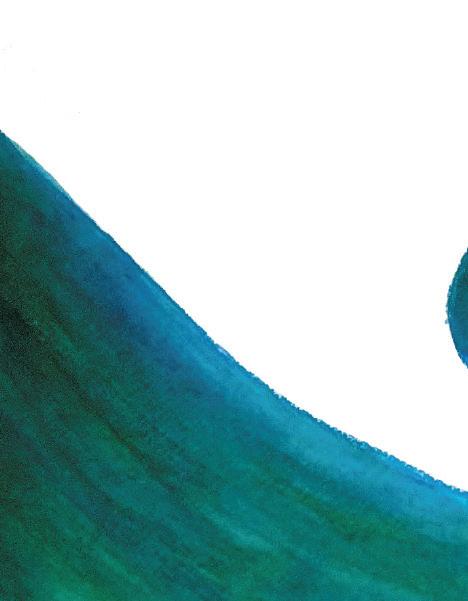
illustration by etai smotrich-barr
through the speakers. You throw your head back to match her croon. I laugh in between steps— not because it’s funny, but because I love you.




Large oak trees will line our street. They’d be ominous if they weren’t so saintly. Quiet but never barren, home to laughter and lost kitten signs. Streets that swell with multi-colored leaves come autumn. You will point, placing bets on when they will fall. Just when we think they can’t hold anymore, we wake to find the asphalt submerged under a rust-colored sea. One that crunches under the running feet of eager vampires pushing their fangs back into place. The bloodsuckers are followed in single file by ghosts wearing tennis shoes and fire fighters with pigtails. You and I will wait for them to reach our front porch; the light is on. We pass out king-sized candy bars; our house will have quite the reputation. I make my best costume guess as the little ones arrive on our doorstep and reward them with sweets regardless of my blunders. When we’ve run out of currency, our jack-o’-lanterns still burn bright, so we sit on the rickety steps. When the winds reach our bones, we retreat to the television—back to that flowered couch. We sink into its cushions and I can feel all the other hallowed nights we’ve had together as if they’re happening all over again. We hear wolves howling over the screams of teenagers who need to be treated like adults. You slip out of costume still covered in makeup, half you, half make-believe.

layout by kevin chen
Anaiis Rios-Kasoga
Coming Out, Coming Home
Queer Christians in New Haven and at Yale are finding ways to enrich their spiritual lives through their LGBTQ + identities.
TheNewJournal 42
By Abbey Kim
March 2023 43
Layout design by Kevin Chen
“Four days a week I was going to church,” Holly Nichols told me in the nave of the United Church on the Green. “They waited a year and a half to tell me I was going to Hell.”
Nichols has been religious since the age of six or seven, when she first attended Lutheran services in Hamden with a childhood friend. She described to me how being in church continues to give her a peace she cannot find anywhere else. Despite her love of God, she has struggled to find a church that accepts and affirms her as a lesbian.
About six months before we spoke, Nichols had been attending a non-denominational church in North Haven. She’d been there for around a year—involved with Bible study, prayer group, and services—when she brought her wife to a Sunday service. Shortly after, she told me, one of the five church alders told her that being married to a woman was a sin and that she had to repent. Nichols brushed it off as just one person’s opinion rather than that of the church. But she did not bring her wife back again.
The next intervention came when Nichols attended membership class, hoping to become an official member in the church after more than a year of devoted attendance and financial support. But before she entered the church, a member at the door warned her that she couldn’t become a member if she was gay.
“I think I was in denial that they were going to take it as far as they did,” Nichols said. “I thought they were just trying to make a point, but I didn’t think it would stand in the way of my becoming a member or eventually my being able to attend.”
In September 2022, a year and a half into Nichols’ time with the church, the congregation staged a third, full-on intervention for her. Four alders—those with long-term experience and standing in the church—and two long-standing members surrounded her in a room.
“They went around in a circle and told me why my marriage was wrong, why I was going to Hell,” Nichols said, growing quieter. “And that did test me.”
After that final intervention, Nichols decided to leave that church. She first took some time away from formal religious spaces, instead investing in her personal prayer life, journaling, making gratitude lists—even skydiving.
F“It’s traumatizing to be told that you’re rejected by God,” Nichols said. “It was really hard to feel like it was safe to go back to church.”
After a few months, Nichols began seeking a new worship community, but found it difficult to locate an affirming church. Her search, mainly directed by Google hits, led her to one dead end after another, including uninspiring Zoom-only services and an empty parking lot where a church had once been.
She started attending the United Church on the Green a little over a month before we met. One of her Google searches for an “open and affirming” congregation had finally worked.
“Open and affirming” is a designation created by the United Church of Christ (UCC)—the national Christian denomination to which the United Church on the Green belongs—to assert the full inclusion of LGBTQ+ congregants in church life. The label means not only welcoming queer congregants into the church, but also affirming that their lives are not in conflict with the Bible’s teachings.
In practice, “open and affirming” churches fall along a spectrum; some churches incorporate it as a tenet of their community philosophy, while others—according to some queer churchgoers—appropriate the phrase as a means of drawing in new members. UCC is a congregational church, which means it’s much less centralized than other Christian denominations like Episcopalian, Presbyterian, and Catholic churches. Because of this decentralization, each local UCC congregation can determine its own policies and practices, including whether to adhere to suggested national guidelines. This includes approaches to queer affirmation. State by state, county by county, each congregation exercises their own discretion around inclusion.
Standing by the light-filled pews at the back of the church, Nichols smiled as she told me about bringing her wife to United. She hopes to reintegrate church into their lives together.
“It’s a fresh start without that negative nagging, enemy voice telling me this is what makes me not good enough or this is what separates me from God that they were feeding me at the other church,” she said, as she relaxed her fidgeting hands. “Here I don’t have that. I have peace.”
Nichols’ experience with homophobia in the Church is not unique. Christian spaces and teachings have notoriously
Coming Out, Coming Home 44
created violent and traumatic experiences for members of the LGBTQ+ community—in Connecticut and beyond. But Nichols is also not alone in her persistent desire, as a queer person, to find a Christian community despite these hostile encounters. For the LGBTQ+ members of New Haven and Yale’s religious community with whom I spoke, creating queer spaces and forging new meaning in the church means adapting old traditions and reexamining conventional readings of the Bible. Many say their queerness and spirituality enrich each other.
Reclaiming the Bible
To exist as a queer person in a Christian space is to stand up against generations of canonized, homophobic dogma. Despite newer, affirming interpretations, many church leaders still weaponize the Bible to condemn homosexuality. They often ground these attacks in what have become known as the “clobber passages,” those most cited to condemn LGBTQ+ people as heretical. Perhaps the most overt condemnation appears in Leviticus 18:22: “You shall not lie with a male as with a woman; it is an abomination.”
Congregants I spoke with had varying reactions to these texts. Some cited other archaic rules in Leviticus—like prohibition of eating shellfish or mixing fabrics in one’s clothes, and a decree ordering menstruating women to leave city limits—as proof that some homophobic Christians selectively punish queer people over those who commit other listed abominations.
Others see the process of interpretation as one that changes over time. There are a growing number of theologians who are reading the Bible—particularly these “clobber passages”—with a new lens that recasts them as condemnation of other sexual wrongs, like rape or incest, rather than being overtly homophobic.
“I’m not going to look at it as this perfect document that has been delivered to us today, as it exactly was when it was written,” Cal Swanson ’25, a co-chair of the Episcopal Church at Yale (ECY) who is also queer, told me. “I’m going to look at it as an artifact that has been through centuries of interpretations and changes.”
In the face of the Bible’s weaponization, many of the queer people I spoke with explained how the text could be reclaimed as a powerful tool of love and affirmation. Most told me they
blamed the misinterpretation of Christian teachings for the harm they faced, rather than the tenets of Christianity. Queer churchgoers generally hold the fundamental belief that God is good, loving, and just—even when church doctrines don’t reflect that.
“The greatest harm we have ever done in religion is to not say love yourself first, and you are lovable, and loved,” Rev. Aaron Miller, a transgender man and a pastor at the Metropolitan Community Church (MCC) in Hartford, tells me. “That’s the thing I say over and over again because if you’ve heard it a million times, I want you to hear it a million from me. Because you’ve been lied to.”
Miller was confirmed as a Lutheran and attended Catholic Church for nearly a decade with a former partner. He left the Catholic Church for a number of years before eventually returning to religion and attending Yale Divinity School, graduating in 2008 and working in pastoral care at Yale New Haven Hospital. Then he started attending and later working at MCC, a denomination founded in 1968 by a gay ex-Pentecostal minister explicitly for queer people to worship together.
At the beginning of our conversation, I told Miller—just as I told everyone I spoke to—that I am a lesbian who was raised Episcopalian, having grown up seeing sexuality and religion in fundamental tension with each other. Like the others, he was quick to try to persuade me otherwise.
“You have to really do gymnastics to ignore us in the Bible— the queer folks in the Bible,” he told me, referencing specific passages in the scripture that lend themselves to queer-affirming interpretations, including what he interprets as same-sex romantic relationships and trans representation.
He told me about Jonathan and David, and Ruth and Naomi. He described them as the only romantic couples in the Bible, both of whom are same-sex. Ruth’s vow to Naomi, he said, is even commonly used at straight weddings. He went on to explain readings of transgender identity in the text, telling the story of Genesis 1:27—“So God created humankind in his image, in the image of God he created them; male and female he created them”—as connoting not separate beings but the fact that we contain the potential for both genders within us, embodying spectral identities.
March 2023 45 TheNewJournal
Perhaps the most overt condemnation appears in Leviticus 18:22: “You shall not lie with a male as with a woman; it is an abomination.”
“It’s so strange to me that this is the same text that’s used against gay people,” said Rev. Ali Donohue, chaplain at the ECY and a lesbian. “It’s so clear to me how much of this message is helpful, and familiar, and home.”
Creating Space
As older churchgoers were quick to remind me, to come out as queer even as little as fifty years ago could result in anything from forced exile to social isolation in any given church, depending on its denomination.
In 1975, Ken Theriault, then a 21-year-old junior at Yale College, came out as gay. Theriault had been raised American Baptist, “singing in church choir since they had a robe small enough for me.” He began studying at the Yale Divinity School, hoping to be ordained in the American Baptist Church even as it became clearer that he would not be able to serve in their ministry because of his sexuality.
Alongside Beverly Lett, a fellow student at the Yale Divinity School, Theriault founded a new branch of MCC in New Haven in 1977. The expansion filled a void, Theriault said, creating a space of formal LGBTQ+ religious acceptance in New Haven at a time where no churches allowed or affirmed queer worshippers and leaders.
At its first meeting, MCC New Haven met in the small upstairs parlor of a local Methodist church. There were about fifteen attendees, most of whom had heard about the church through word of mouth or the MCC Hartford newsletter, Metroline. MCC New Haven also joined with the New Haven chapters of Integrity and Dignity—an Episcopalian and a Catholic gay religious group, respectively—for monthly potlucks at members’ homes.
From 1977 to 2015, MCC New Haven moved across several churches and hosted anywhere between twenty and one hundred congregants a week.
“It was a real church. Just the population was a little different,” Theriault told me. “A place to gather and sing and hear sermons, I mean it was a regular church service. We weren’t playing church.”
Theriault found that even though local churches weren’t openly affirming of queer people yet, they accommodated
Theriault and Lett’s requests to meet in their space, often for free.
“It was the gay community wanting to worship with itself,” Theriault explained. “Just the fact that there were three congregations that were willing to house us, and saw that as important as part of their mission—there was some acceptance there.”
The church advertised through word of mouth, as well as what Theriault called a “bar ministry,” in which members recruited patrons of local gay bars like Partners Cafe and passed out leaflets advertising the church. Later, the church accrued more formal local coverage, including a 1979 profile of Theriault in the New Haven Register entitled “New Haven Church Offers Sanctuary for Homosexuals.”
“I would say most of us came with some negative experience, and that’s why we’re looking for something else,” Theriault told me, forty-four years later. “People still have their spirituality and want to express it somehow.”
Participation at MCC New Haven eventually dwindled. Co-founder Lett left in 1979, and the church struggled to hold down a permanent location or pastor. As more of New Haven’s churches became accepting of queer worshippers in the early 2000s, the need for a specifically queer church diminished, and social schisms proliferated within the MCC. Today, there are no gatherings of MCC in New Haven—parishioners can join the MCC Oasis Zoom group or travel forty-five minutes to Hartford.
MCC still exists—across the United States and twenty other countries—but it faces struggles unique to being a queer church amid a broader landscape of declining church membership and aging parishioners. A lack of an endowment or the security of a historically owned space makes stability nearly impossible, explained Sharron Emmons, a member of the Board of the Directors at MCC Hartford and a lesbian. She added that the historical lack of queer families—and thus the opportunity to raise children in queer churches—hurts growth.
“Early on, if you wanted to go to church, [MCC] was the church you went to, unless you wanted to be closeted. But as different congregations opened up, now you didn’t really need an MCC,” said Cathy Vitelli, a lesbian and former member of MCC New Haven who moved to an Episcopalian church. “You’re more comfortable there. [But] you could find a community someplace else.”
Coming Out, Coming Home 46
“It was the gay community wanting to worship with itself,” Theriault explained.
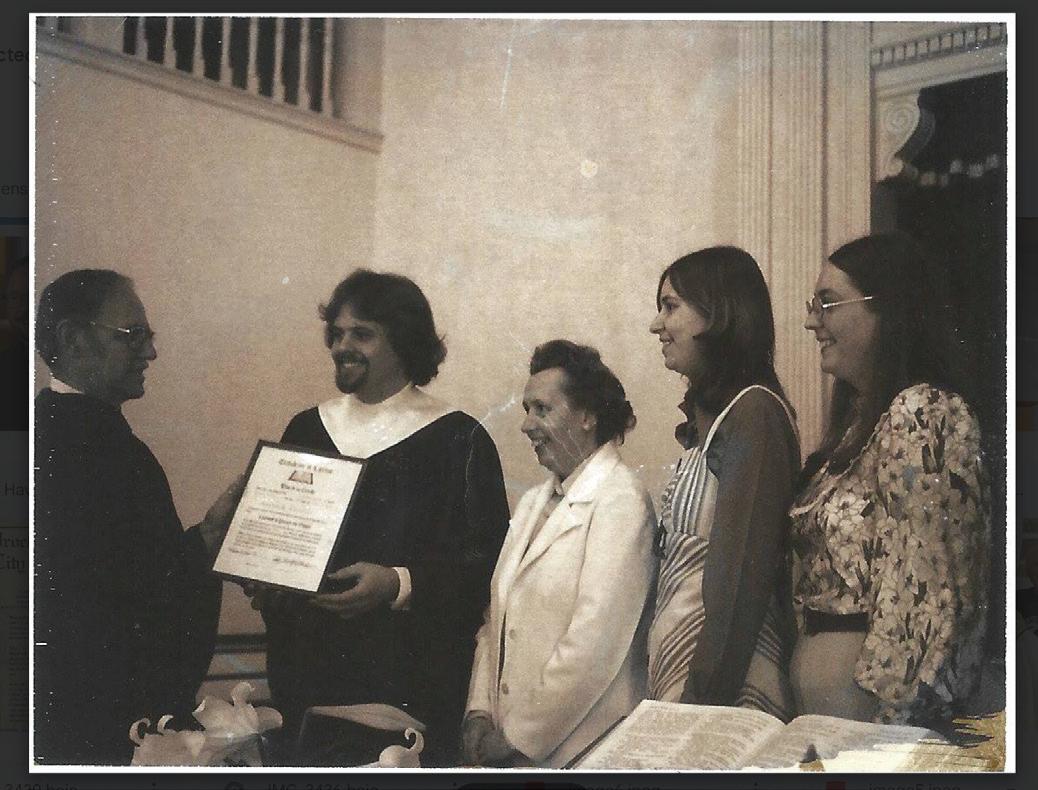

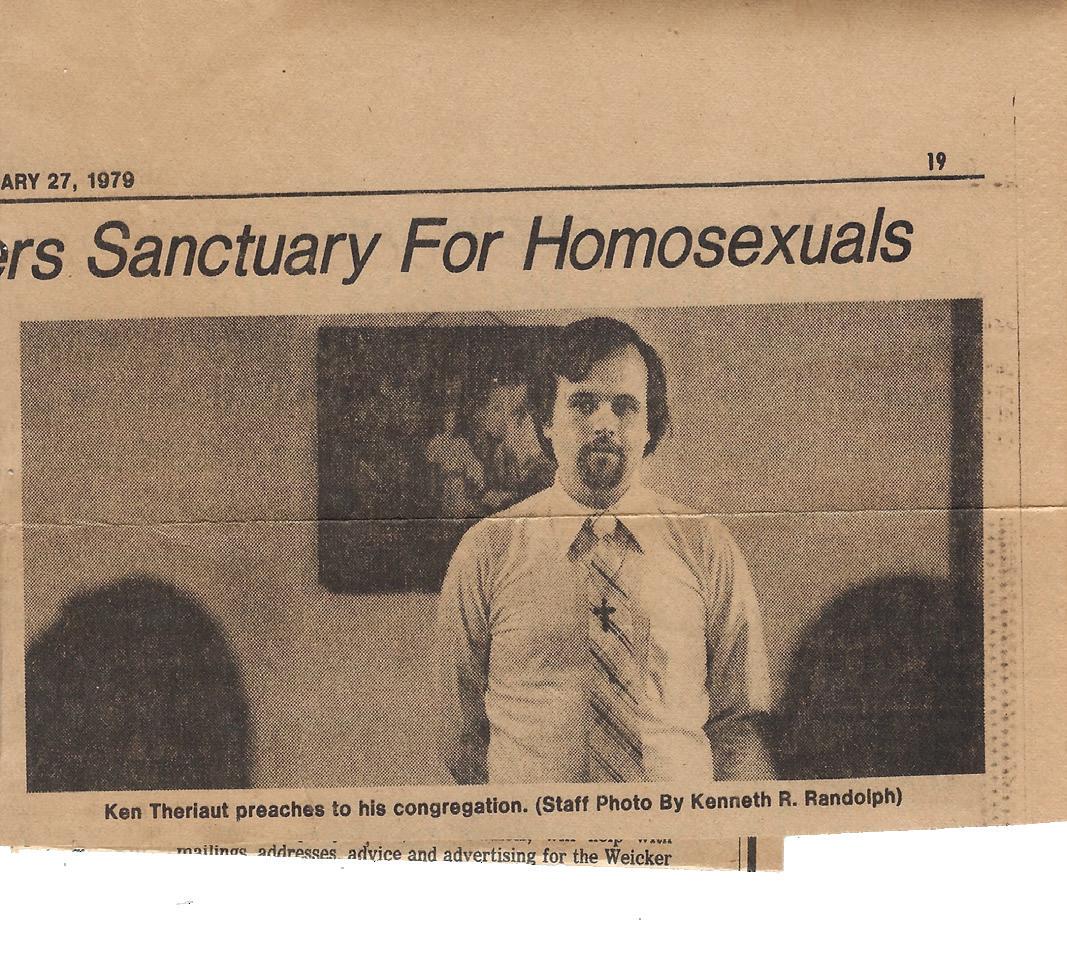

March 2023 47 TheNewJournal
Ken Theriault, second to left, receives his license to preach in 1978.
man and a pastor at mcc in Hartford.
Photo courtesy of Aaron Miller
Courtesy of Ken Theriault
Photo courtesy of Ken Theriault
Finding God, Again
While most of the queer churchgoers I spoke with cited affirming interpretations of the Bible as helping them reconcile their faith and queerness, they stressed the greater importance of church as a site of that interpretation and burgeoning community, one that could transcend the text itself. The physical space and communal tenets of a church could provide shelter, refuge, and community in a way that the Bible alone couldn’t.
“I don’t know if it’s because we’ve been deprived of religion for so long, but there’s more of a yearning for it in the [LGBTQ+] community,” Alfred Forino, Moderator at United Church on the Green, tells me as we talk over coffee.
A skinny wooden cane, with a handle carved into an ornate crocodile head, leans against his chair—this is his lucky charm. At sixty-five years old, Forino has been a member of United for twenty-three years. The first time he attended a service at United, he remembers, he was so overcome by emotion that he cried through the whole sermon.
Forino is gay. Like many queer people, he has navigated a complicated relationship with church.
“Growing up as a Catholic, I was very lucky that I had a good enough sense of my own self because what I heard from the pulpit was just homophobia,” Forino said. “There was a brief time where I prayed to change, [but] I realized very quickly that wasn’t going to happen. But I also had enough self worth to know that God made me this way.”
Forino ended up marrying his husband, Eric, at the United Church on the Green in 2005, three years before it was officially legal in Connecticut and ten before it was federal law. He was quick to point out to me the significance of having a church recognize the validity of their partnership before the government did.
Rather than leaving church altogether when they faced homophobia or belittlement, the queer Christian and religious people I talked to were determined to keep pushing for a church that would accept them—whether that meant encouraging their church to be more affirming or searching for a new one altogether.
“The church is a community where people can gather together and worship God and seek to be faithful to God. But
it’s also flawed and very human,” Rev. Jocelyn Cadwallader, a lesbian pastor at First Presbyterian Church of New Haven, told me. “I’ve always been very clear of separating those two things: that the church is not a God.”
Cadwaller learned this distinction firsthand. She was raised Presbyterian and had been involved with her local church from a young age. Despite the fact that the national Presbyterian Church at the time did not allow openly queer people to be clergy, Cadwallader still felt compelled by God to serve in the ministry as a priest, and attended seminary school in 2004. She emphasized a commitment to staying within the Presbyterian denomination, despite its nationally hostile regulations, because her local church community had helped raise her and always supported her.
“I never felt interested in moving somewhere different for the sake of my own sexuality,” Cadwallader said. Instead, she hopes the denomination will grow into what she feels God calls the church to be—affirming of all its congregants.
Many queer congregants I spoke with emphasized Cadwallader’s idea of church as a pillar of community and an extension of their social, cultural, and familial history. This belief can be especially strong with queer Catholics.
“I see the Catholic Church as not just something you hop in and out of as you sort of church shop. I see it as a community to which I belong,” said Stephen McNulty, ’25, a gay Catholic at Yale and an active member of the LGBTQ+ Ministry at St. Thomas More (STM), Yale’s Catholic chapel.
McNulty echoed an idea shared by others: abandoning the churches he’d grown up in because he was queer could feel even more wrong than staying in a non-affirming denomination.
Jacquelyn Oesterblad YLS ’22, a Catholic and lesbian who helped found the St. Thomas More LGBTQ+ Ministry, believes that she is showing respect for the Church by thinking it has room for her. “There is definitely still defiance of like, I’m not going to let them have the Church,” she said, referring to homophobic Catholics. “They’re going to have to deal with my baptized ass as well.”
Oesterblad stressed the importance of queer representation even in non-affirming spaces, which she noted will inevitably host new generations of queer children looking for role models.
Coming Out, Coming Home 48
The first time he attended a service at United, he remembers, he was so overcome by emotion that he cried through the whole sermon.
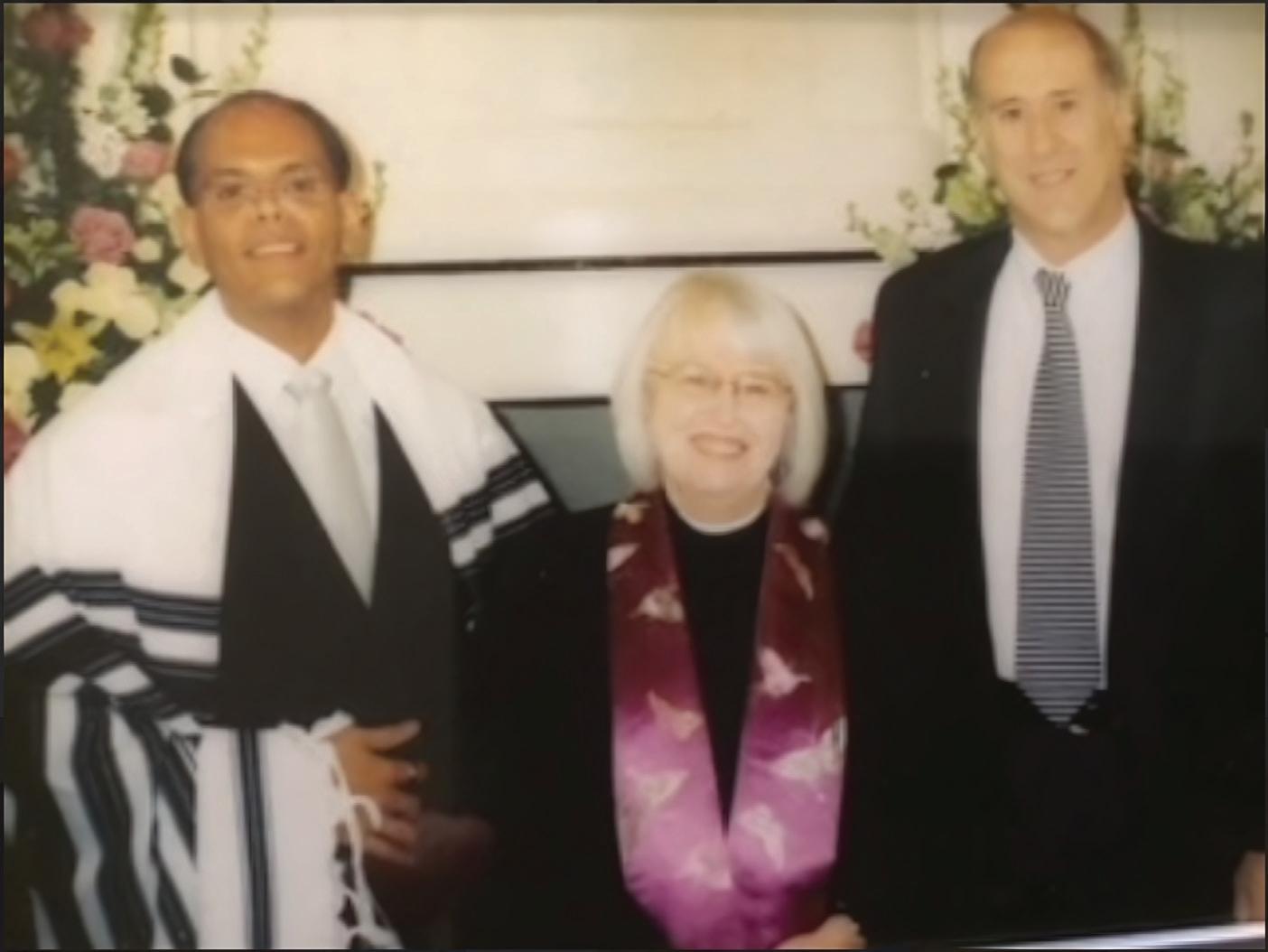
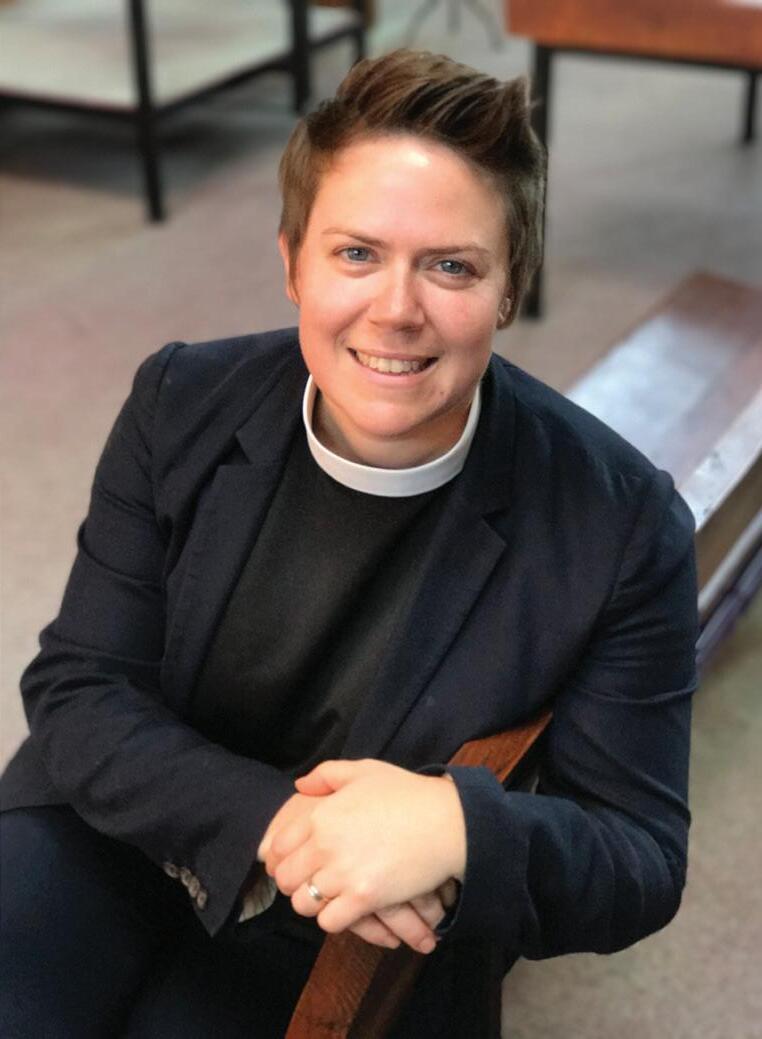
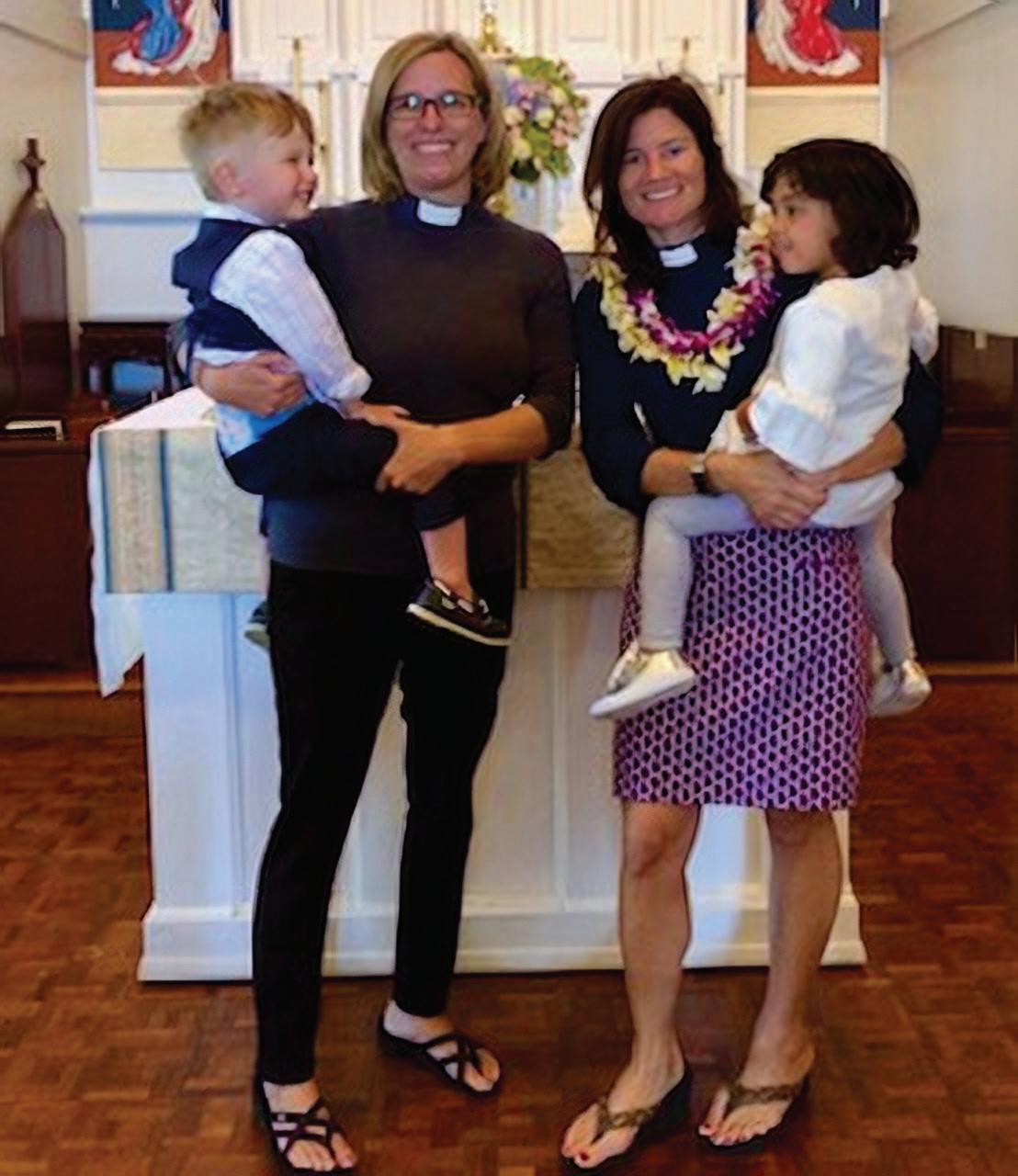
March 2023 49 TheNewJournal
Al Forino, right, and his husband, Eric, following their marriage vows at the United Church on the Green.
Rev. Jocelyn Cadwallader is a pastor at the First Presbyterian Church of New Haven.
Rev. Ali Donohue, chaplain of ecy, with her wife Rev. Kerith Harding and their two kids.
Photo courtesy of Jocelyn Cadwallader
Photo courtesy of Alfred Forino
Photo courtesy of Jacquelyn Osterblad.
“As long as queer kids are being raised in this church—and they will be—I think it’s better for them to see people like me in the pews than to not,” Oesterblad told me. She emphasized she does not try to recruit queer people into the Church. Instead, she works with others just like her: baptized Catholics trying to navigate hostile yet familiar spaces.
While McNulty and Oesterblad are not alone in their identities, many of the queer people with whom I spoke who were raised Catholic ultimately left the denomination for a variety of reasons. Some, like ECY ’s Rev. Donohue, realized that, despite their love of the faith, it would not make room for their marriage or official ordination. Others, like Forino, were unwilling to endure homophobia and partial membership due to their sexualities.
In New Haven’s affirming churches, some queer churchgoers disregard the religious element of church altogether, staying for the welcoming community and its benefits for fostering queer connections and social justice.
“From a Christianity and believing-in-God point of view, there’s none of that there for me, it’s not what works for me,” says Emmons, who has spent decades at both MCC New Haven and MCC Hartford despite being an atheist.
“But I’ve seen the church save lives. People come to our church, broken—older people, especially because it was tougher in the past—where they were kicked out of their families, kicked out of their churches,” Emmons adds. “Our message is ‘come out, come home, and come back.’ Here’s a place where you can re-find your God.”
And many queer people are intent on doing just that. I was shocked by the number of queer religious people I stumbled upon—young and old—in churches at Yale and New Haven. At the United Church on the Green alone, I chatted with three queer churchgoers out of a crowd of around twenty people.
One of them was Darnel Ray, a middle-aged gay man who sat in the pew in front of me and hummed “mmhmm” in agreement throughout the service. Having been raised American Baptist, Ray continued to crave Christianity even after his coming out was a source of conflict between him and his parents. Years later, in 2019, he saw the pride flag outside of United and decided to try it out. He’s since moved to West Haven but still
commutes about twenty-five minutes for services. He’s uunsure if the church closer to where he lives is accepting, and he’s nervous to find out.
From the Altar
As more openly queer individuals join religious communities, queer leaders face a dilemma: do they spearhead progress towards greater acceptance or seek out already affirming spaces? Some, like Donohue and Cadwallader, opt for churches that have made strides towards inclusion. Others, like Oesterblad and McNulty, find that the nature of non-affirming spaces thrusts them into leadership roles since their mere presence challenges the status quo. This tension between leading change and seeking acceptance animates church communities at New Haven and Yale.
Donohue noted that she and her wife, who is also an Episcopalian reverend, choose local churches that are already affirming. But this choice only came after Donohue left the Catholic Church, in which she’d been raised and educated for decades of her life.
“I experience [queerness and religion] as a source of strength, I observe it as a source of pain,” Donohue explained, noting the queer students she’s worked with at Yale are often the ones struggling the most. “My only hope is that I’m able to have people join me where I’m standing, because I see zero conflict.”
At Yale, there are only four explicitly affirming Christian groups out of twenty ministries, explains Rev. Jenny Peek, an Associate University Chaplain and lesbian. “Explicitly affirming” here means believing in the full inclusion and affirmation of LGBTQ+ people (including celebrating queer marriages and ordination) and advertising themselves as such. These groups are the Episcopal Church at Yale (ECY), the University Church at Yale (UCY), LuMin at Yale, and Yale Progressive Christians Students. Peek added that the landscape can sometimes be difficult for incoming queer students to navigate.
St. Thomas More walks a thin line when dealing with queer students as a Catholic university chapel. The church can—and does—welcome queer students, but it cannot formally affirm
Coming Out, Coming Home 50
“There is definitely still defiance of like, I’m not going to let them have the Church,” she said, referring to homophobic Catholics.
“They’re going to have to deal with my baptized ass as well.”

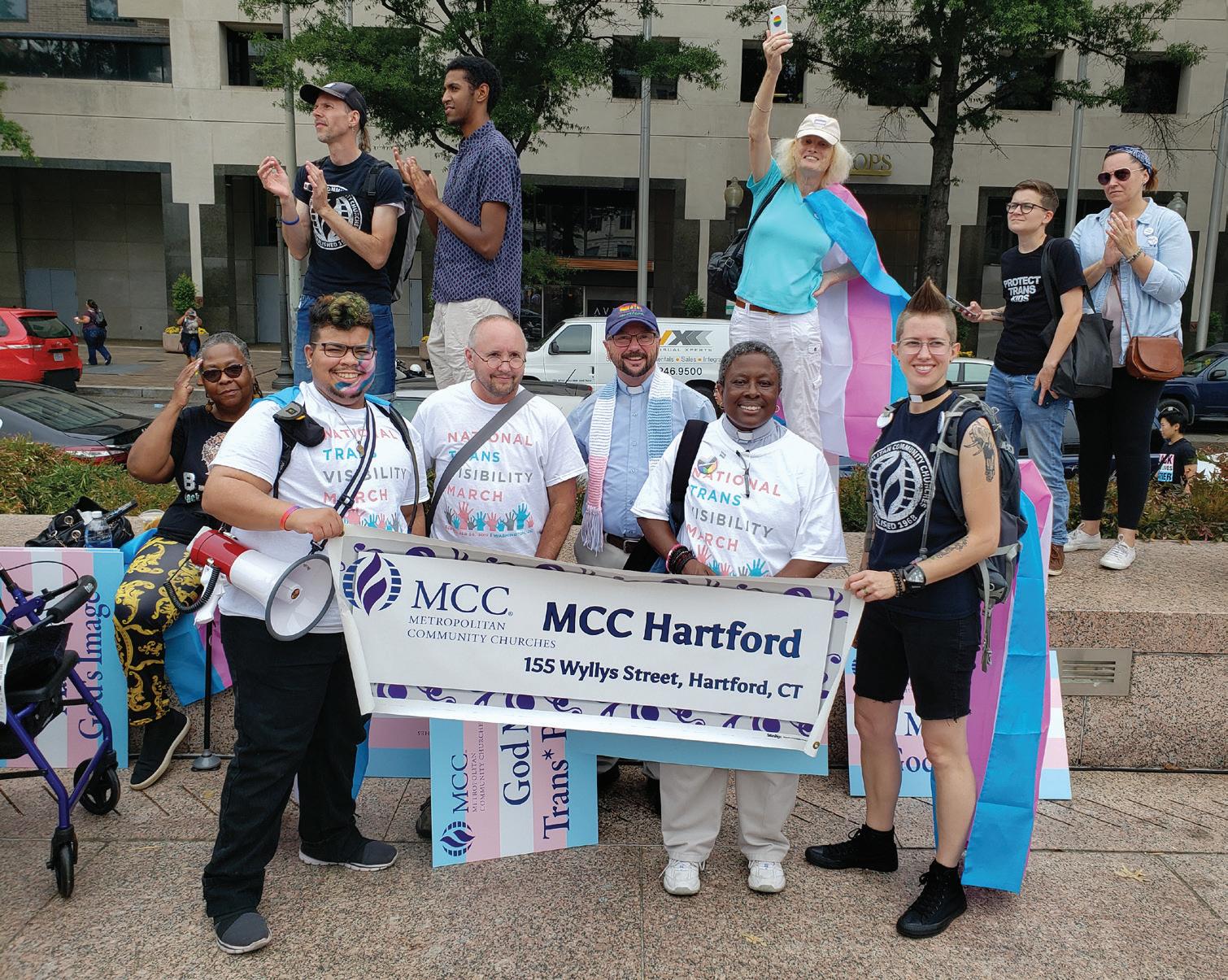
March 2023 51 TheNewJournal
Rev. Jocelyn Cadwallader holds her daughter while in the pulpit, and her son is crawling up in the foreground.
mcc Hartford aims to protect and support the local queer community.
Photo courtesy of Jocelyn Cadwallader
Photo courtesy of Aaron Miller
them in their ability to live out their queerness, particularly in sexual relationships. This would be a violation of Catholic teachings.
Oesterblad recalls being thrust into a leadership role for the LGBTQ+ Ministry at STM—a ministry affinity group founded during the pandemic—as one of the few openly queer people in the church. Laughing, she remembers wishing she could join an already existing space: “Can I just plug into something that already exists and be ministered too, please?” Oesterblad ended up helping to create, design, and lead the ministry.
In the midst of this landscape, queer chaplains at Yale can offer a beacon of representation and affirmation. “Knowing that she’s queer and she has this amazing understanding of the Bible being about love and being about affirming your LGBTQ identities is so helpful for me,” Swanson said of Donohue, who leads his church. “I feel like I absorb some of my certainty about it from her. And so I think it’s been a big thing having a queer chaplain.”
Outside of Yale’s walls, queer reverends often engage in the same kind of affirmative work, though for a much broader audience—not just young adults. But the pastors I spoke with noted that the churches that call these queer leaders are often already accepting and progressive.
Rev. Cadwallader of the First Presbyterian Church recounted a time that a congregation offered her a job with the disclosure that about half of the congregation was not ready for a queer pastor. The hiring committee hoped she could change their minds. She ultimately turned them down: “I’m not in the business of splitting churches . . . That journey needs to be done by somebody else.”
But not every queer member of non-affirming spaces feel that they have a choice.
“I’ve often been the one who starts conversations,” McNulty said of his work at the STM ’s LGBTQ + Ministry. “And I’m okay with that.” He starts these conversations with a contradiction
he says he incurs “by virtue of existing”: being a gay Catholic.
Ultimately, queer religious leaders across New Haven can usher in a more accepting space, buttressed by the virtue of representation. Cadwallader says her queerness is a strength when she preaches to all her congregants—even those who aren’t queer.

“I get to remind them again about who Jesus is in their lives and why Jesus is important,” Cadwallader said. “And they tend to listen to me because I am the voice of the one that was told for so long that I shouldn’t be there.”
Coming Home
“Do you have a church home ?” Nichols asked me when we first met in the nave of United. She echoed the common language of many that I spoke with—a church where I could belong, be affirmed, and return to, no matter where I was in life.
I told her how I had grown up in the Episcopalian Church, but now I was more of a Christmas and Easter Christian. I worried I’d stopped believing too soon, and I didn’t know if there was a future path for me.
After we finish talking, I thank her for opening up about her story. She looks at me, holding eye contact as I close my notebook. I have a strange feeling, like I’m about to cry.
“I hope this project opens your eyes to whatever it is you need to see,” Nichols says. “I hope you find whatever it is you’re searching for.”
I think I’m starting to see. Perhaps more than queer people seeking and finding religion, I’ve found them reclaiming it— coming home. ∎
Coming Out, Coming Home 52
Abbey Kim is a sophomore in Branford College and an Associate Editor of The New Journal.
Photo courtesy of Aaron Miller
The chapel at mcc Hartford.
for Abel
Genesis 4:10
Forgive me, my brother; or do not. I’m sorry for envying your hands, the way they never failed to be gentle when they ran through the wolf’s fur, and the wolf fell to slumber; when they wrung the lamb’s neck who felt no need to bleat in pain for her mother, having understood the wringing. Do you
Remember, in the garden, when we pressed our palms together? Mine were calloused and caked in dirt, and the smoothness I felt in yours made me weep. In your arms I sank, the dirt stuck, my eyes bloodshot. When we returned home, our father asked what had happened, and I never explained it, and you never could.

Forgive me, my brother, for knowing you will. I am walking toward nowhere, eating fruit from a gnarled branch, and if I ever may return, I will tell our Father to look for the bed of daisies rustling even in the iciest wind, and there you will rest forever, my brother, bloodless as you came
J.D. Wright
March 2023 53 TheNewJournal
illustration by charlotte rica
Berlin Poem for Owen
i. I laugh when I realize you’re also noticing the near-naked men in leather harnesses on elevated platforms, everyone feigning nonchalance in the line. You look so polished in your white button-down, so controlled and untouristy we don’t struggle getting past the coat check. Then bursting into the club with you, the guttural thrum of techno and how you aren’t afraid to dance, haven’t been since that boy called you a faggot in the tenth grade. When you’re turning around to get a drink, I find myself randomly in awe of your sturdiness, wanting to tell you we came this far or something equally trite but instead I let you disappear onto the balcony. We grant each other our private fantasies, knowing only a few can converge,

lines perpendicular for a long second. That’s how it is, I think, inarticulately, as you return with a gin and tonic, the sort of Zen repose I only get when you’re moving your hips, about to tell me a joke.
ii We don’t get home until sunrise, the streets orange-tinted and industrial. Too riled to sleep, we watch a free movie about a teenage drug addict. We are burrowed on the couch like immobilized cats, grotesque, not needing beauty. That is exactly what you do for me. When I met you, we were chubby, suburban, poorly dressed, fourteen. We didn’t know the first thing about our bodies.
We ate together every lunchtime.
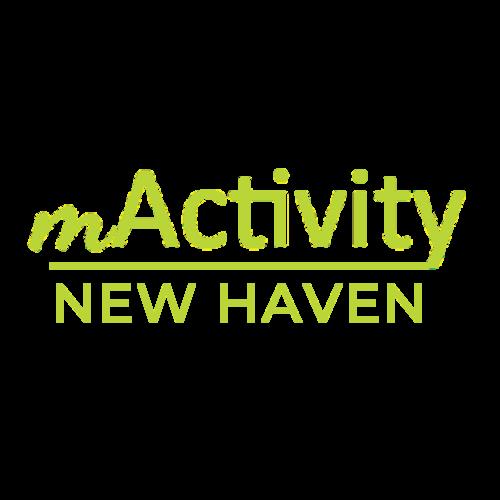 Ella Goldblum
Ella Goldblum
The healthy whole body cryotherapy that everyone is talking about! C O M E A N D T R Y I T O U T @ M A C T I V I T Y www.mactivity.com/free-pass 285 Nicoll Street, New Haven, CT 06511 (203) - 936 - 9446
66 Sesame, Jump and Elm, in short
67 “Sic, boy!”
68
DOWN
1 “No more for me, thanks”
2 Moolah
3 Place for archery practice
4 Stopovers for travelers
5 Give a wave
6 Insectoid enemy to Godzilla with a 250meter wingspan
7 Trendy berry
8 Chap
9 Irish-born Tony winner Patrick
10 Whichever
11 Fell back, as an army
13 Ties the knot, so to speak
40 Boo
42 Alley-___
44 Homes away from home for diplomats
46 Popeye’s anchor, e.g., for short

48 Slim Shady
50 Like a gym rat, slangily
52 Cty abandoned by Lot
53 Sample given to a drug tester
54 Twins usually share them, briefly
57 “You tagged me!”

58 Confront
60
62

The New Journal was founded in 1967, under the following mission statement: “This university has once again reached that stage in history when people are talking about the New Yale, presumably to be distinguished from the Old Yale, which in its own day was presumably considered new. Wishing to share in this modernity, we have chosen The New Journal as the name for our publication. Besides, things seemed slow around here.” Today, The New Journal is published five times during the academic year by The New Journal at Yale, Inc. Two thousand five hundred copies of each issue are distributed free to members of the Yale and New Haven community. The New Journal is printed by TCI Press, Seekonk, Massachusetts; bookkeeping and billing services are provided by Colman Bookkeeping of New Haven. Office Address: P.O. Box 3311, New Haven, CT 06515. While this magazine is published by Yale College students, Yale University is not responsible for its contents. All contents Copyright ©2022 by The New Journal at Yale, Inc. All rights reserved. Reproduction either in whole or in part without written permission of the publisher and editors in chief is prohibited. Recycle Icon from Flaticon.com. ANSWER TO PREVIOUS (JANUARY) PUZZLE PLAY MORE TNJ CROSSWORDS ON OUR WEBSITE! PLEASE RECYCLE THIS MAGAZINE ACROSS 1 Elba of “The Suicide Squad” 6 Precursor to lava 11 Expensive Persian product 14 2016 animated film scored by Lin Manuel Miranda 15 Poet Vuong 16 Chemical suffix that’s also a direction 17 Like one often beaming 18 Sharp-tasting, as sour fruits 19 Hashtag below a nostalgic post 20 Color on the walls 21 22 Perform successfully, as a finance bro might say 23 Beginning of many band names 24 Crew implement 25 “And so on and so forth” 28 Click the paperclip icon 31 What Old Testament sinners might incur from God 32 DVR devices with a distinctive peanutshaped remote 34 Literary orphan Cabret 36 Little piggy, in nursery rhyme 37 Pass time in the shower, say 38 Ending with “pan-” or “di-” 40 Contortionist’s feat 41 There are 1.609 in a mi. 42 Washington bills 43 Actors taking solo bows 45 The best is ___ come 47 “Get what I mean?”, slangily 49 Featuring missing from a tube top 51 Group hunting Frankenstein’s monster 52 Classroom temp 55 Lose at a gambling table 56 Important info for an Airbnb guest 59 60 Common Market letters 61 Soldier getting walloped by Asterix or Obelix 62 The “I” of I.P.A. 63 Snitch 64 Literary character who said
and curioser!”
“Curioser
65 Material for sharp keys?
“The ___ true for me”
12 Prepares to take off
band, for short 24
on the periodic table 27 28 Part of G.P.A.: Abbr.
Climax of an action film
What you might do if you have an earworm
“Come to dinner!”
Teaches
Faster than a trot or canter
Neck-straining NYC attractions
21 Narrator of the Sherlock Holmes stories 22 “Fortunate Son”
26 He.
29
30
32
33
35
37
from sports betting, for short
39 One forbidden
Griner’s
59 Brittney
org.
use for an old
61 New
shirt
** REDACTED ** Puzzle
by Jesse Goodman
55 TheNewJournal
© The New Journal March 2023
The Gender & Sexuality Issue
Danya Blokh is in for a night of non-denominational, non-binary hardcore at Space Ballroom. 4
Jools Fu writes about violence and masculinity in the Singapore Armed Forces. 6
Sasha Carney tells a genealogy of lesbian social spaces at Yale. 10
Hannah Szabó draws it out with local trans advocate Tony Ferraiolo. 28 the new journal


 By Sasha Carney
By Sasha Carney

 By Abbey Kim
By Abbey Kim




 By Jools Fu
By Jools Fu

































































 Ella Goldblum
Ella Goldblum











